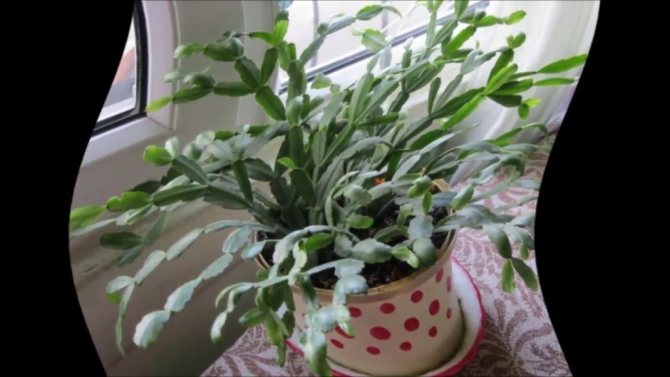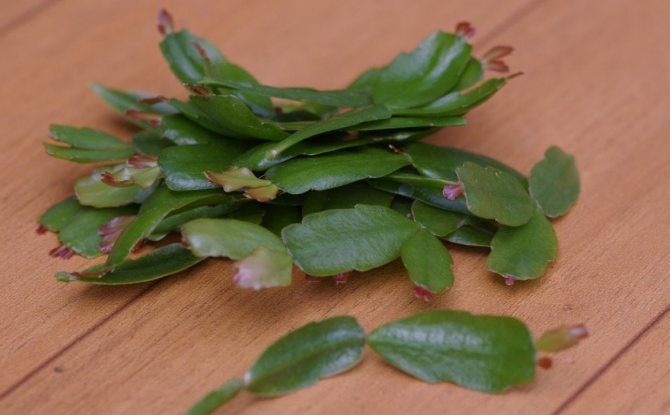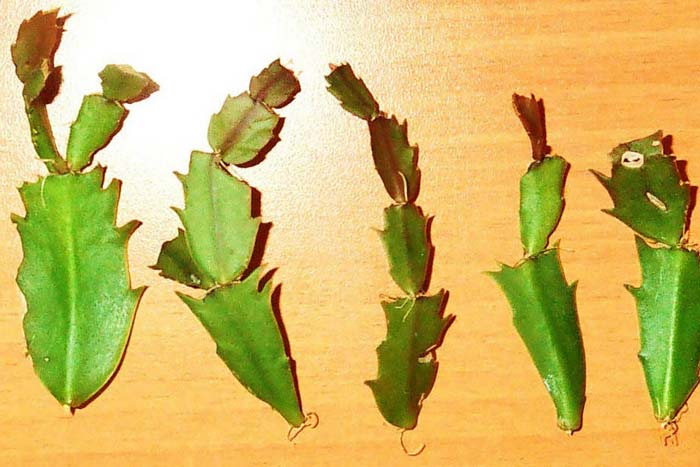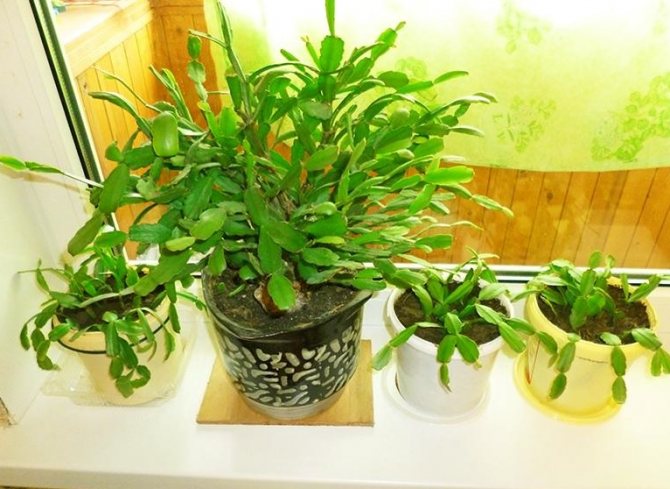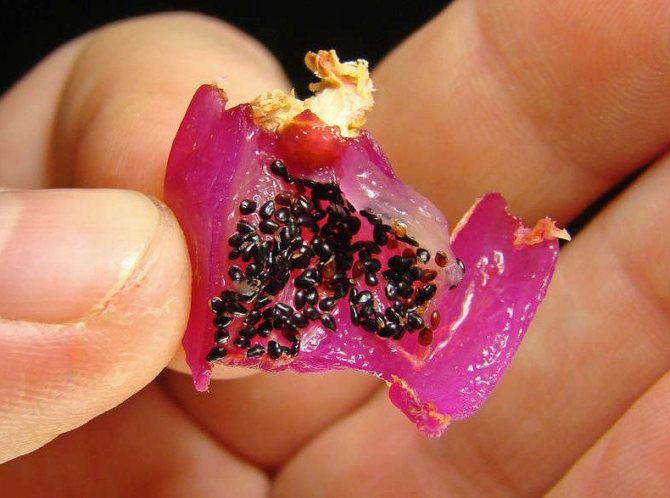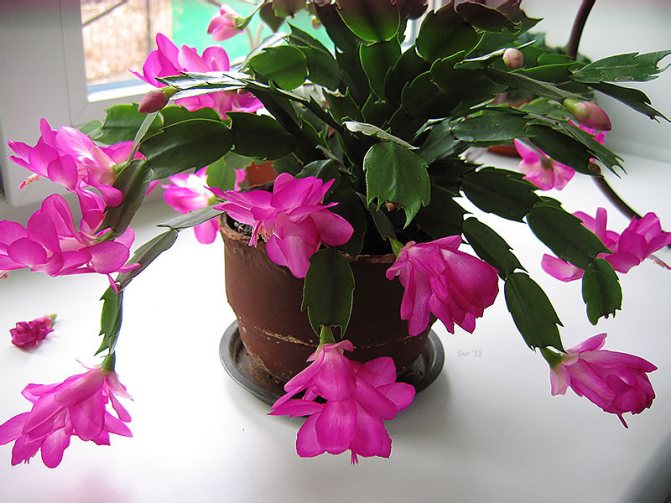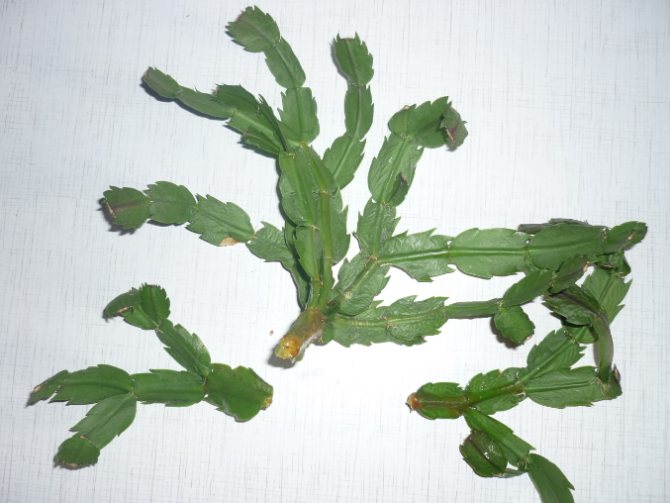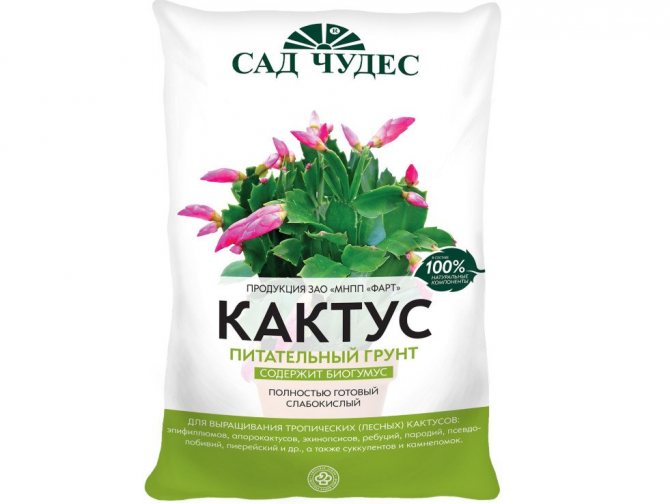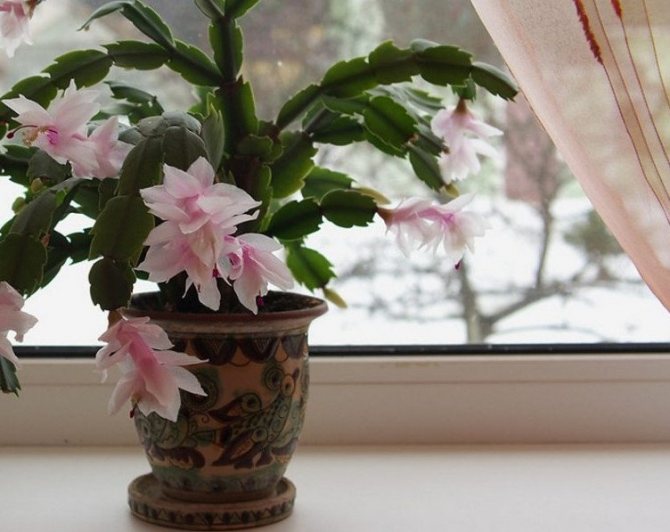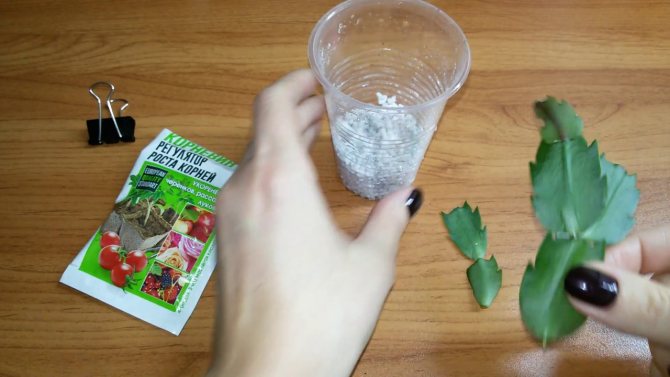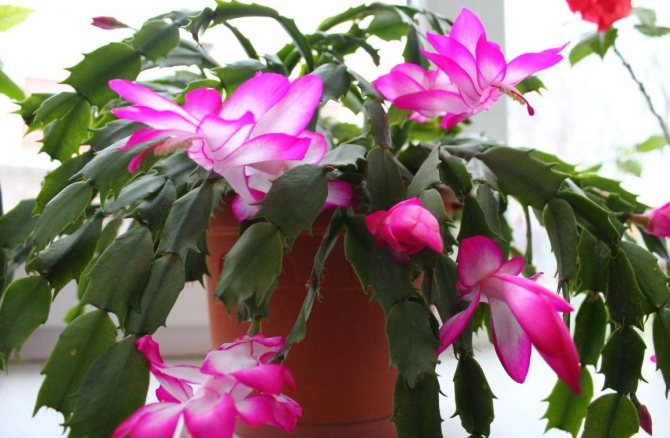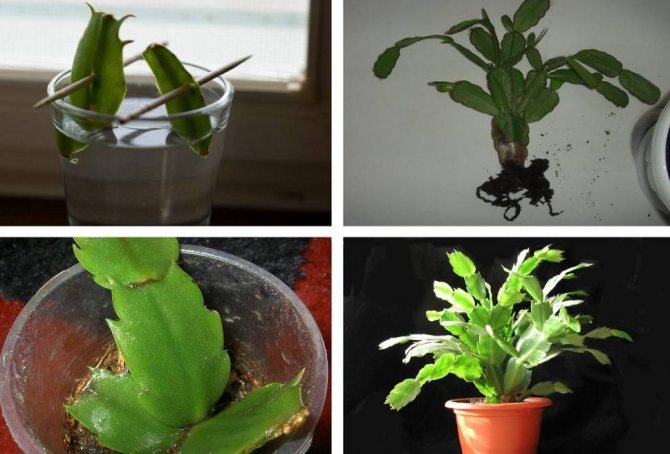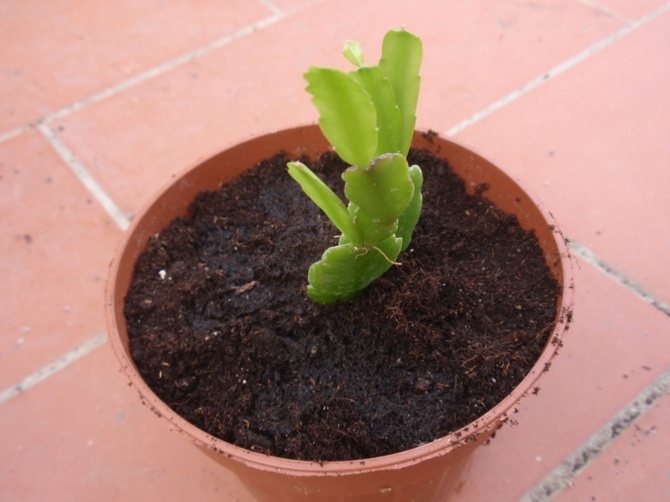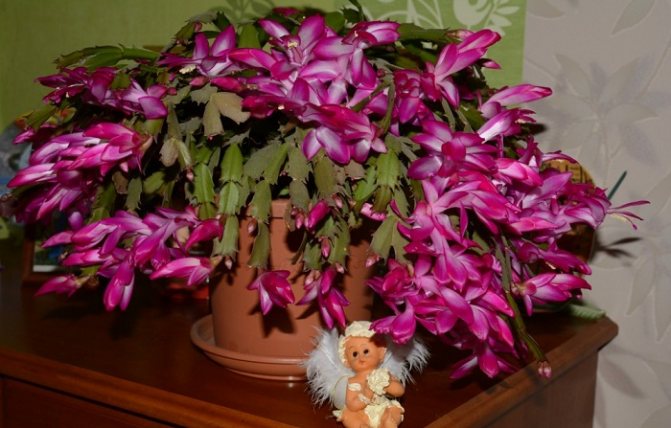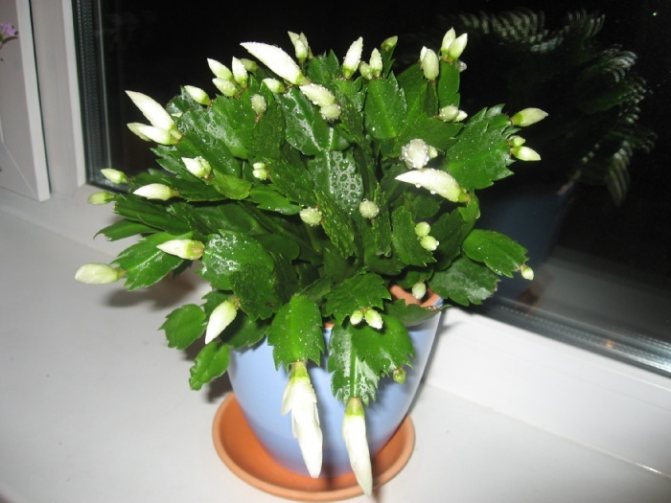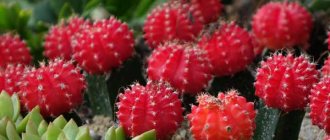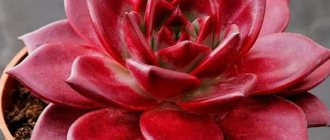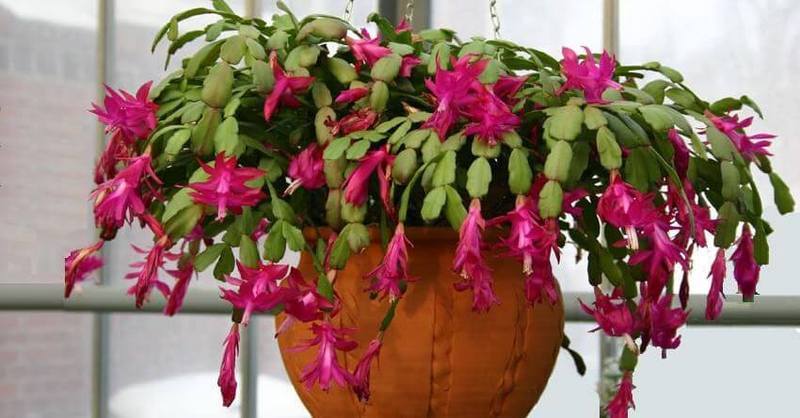
Many people are surprised to discover that there are many things in the world that we could not even guess about, and for novice gardeners, some plants may seem completely mysterious and incomprehensible. For example, can you imagine that there is a cactus that has absolutely no needles, hates direct sunlight, and also loves abundant watering and good fertilizers quite a lot?
If not, then you are definitely not familiar with the Decembrist, who has the scientific name Schlumbergera, and is also familiar to many under the name zygocactus, which blooms with flowers of unearthly beauty when the rest of the "inhabitants" of the windowsill are in a state of winter dormancy. It is about how the Decembrist-flower reproduces at home, what needs to be done in order to grow a similar miracle for yourself, which can delight the eye with bright and unusual inflorescences all winter, and will be discussed in our article.
Short description
The Decembrist is original and unusual, differs from all cacti in the absence of thorns, loves water and does not receive much sun. Blooms in winter, when most ornamental flowers are dormant.
There are many names for this plant, the most famous are: Varvarin spit, zygocactus, epiphyllum, cancerous neck and Rozhdestvennik.
- There is another name - Schlumberger. It is a botanical name that is common to three cactus species: Schlumberger Gertner, Schlumberger Truncated and Schlumberger Buckley. Its origin is simple to explain - it was given in honor of the breeder Frederic Schlumberger, the breeder of their France. But that's what we call this decorative flower quite rarely.
- The homeland of the plant is considered to be the humid forests of South America, in particular Brazil. In nature, reproduction occurs by spreading to the sides from the center of the bush.
- The plant belongs to the genus of South American epiphytic cacti that live on trees, or rather, their branches. They were brought to our area back in 1816 by the collector Allan Cunningham and, over time, became the real pets of many flower growers.
- We used to call this tropical plant the Decembrist, because its peak of flowering falls on December 17, and on New Year's holidays, the Christmas tree pleases us with a magnificent color.
- The branches of the plant are presented in the form of flattened articulated shoots (segments), which grow stiff as they grow.
- Flowers appear on the shoots in tiers. The color palette can be very diverse: soft lilac, lavender, pink, cream, red, coral, light orange. The most famous and recognizable is the gentle - crimson color.
- The root system is rather poorly developed. If the conditions are not quite suitable for the flower, it can quickly die. But, despite this, the search roots tend to quickly recover and develop a normal full-fledged root system.
- Today, breeders are developing more and more new varieties and hybrids that can bloom not once a year, but as many as 3, and their color range is more diverse.
The nuances of reproduction of the Decembrist by grafting
A very interesting way, available for home use, if you have or need to. They are used as a rootstock.
The process itself is as follows:
- Choose a scion from the Decembrist: no more than 3 healthy segments. Without cutting it off, in the lower part, where the 3rd segment grows from the previous one, clean the last segment. To do this, cut the edges obliquely.
- Cover the cuts with charcoal and leave the scion in this form for 5 days to dry the wounds.
- Cut off the top of the rootstock and split it. The higher the trunk left, the more beautiful the result will be.
- Separate the scion from the old Decembrist and insert into the rootstock split.
- Fix the graft with a cactus thorn and wrap with thread.
- If new shoots appear on the rootstock in the process of taking root, remove them.
Reproduction by grafting will allow the Decembrist to "acquire" a trunk that he does not have. Thanks to this, cactus shoots hanging from a height look much more beautiful.
Where did the winter fairy tale come from
The Decembrist is an American. The birthplace of lush charm is Brazil. There the zygocactus grows, attaching itself securely to tree trunks. Christmas is an epiphyte. The crowns of the breadwinners are reliable protection of the cancerous neck from bright sunlight.
Schlumberger is a peculiar cactus. The flat stems branch out in all directions. Like any cactus, Schlumberger has no leaves. Flat segments have 2 to 4 teeth. Flowers appear at the tips of the segments.
The range of shades is wide: inflorescences are from pale pink to bright red. These are natural colors. Breeders have succeeded in obtaining inflorescences of yellow and purple flowers.
The cactus pollinator at home in Brazil is a small bird. Hummingbirds carry flower pollen on their long noses. The plant loves moisture and prefers diffused light. The Christmas tree absorbs harmful substances, purifying the air. The cactus lives to be 30 years old.
Top dressing
Decembrists need feeding. For this, you can use complex fertilizers intended for epiphytic plants. If it is not possible to purchase them, use complex fertilizers. In this case, the dose indicated in the instructions is halved.
In the spring, feeding is carried out once a month. In the summer, when the stems begin to grow actively, the plant is fed twice a month. In the fall, all feeding is stopped to allow the plant to gain strength before budding. At the same time, it is necessary to treat the plant with a fungicide in order to avoid fungal diseases.
Planting a Schlumberger does not cause serious problems even for beginners in indoor floriculture. You can choose the most suitable method for yourself - cuttings or sowing seeds. Each of them has its own merits. The shoots root quickly and easily at home, and the seeds usually show high germination.
Features of the
Reproduction of the Decembrist with the help of shoots allows you to get a new plant while preserving all the specific features of the mother bush (color of flowers). The optimal propagation period is early spring. By this time, Schlumberger fades, the vegetation phase begins.
Florists note that the shoots taken in March take root and grow more actively. If the spring period is missed, then you can take material for breeding in the summer, during the formation of the bush.
Information. The Decembrist has no thorns, so there is no risk of injuring his fingers while tearing off the handle.
The number of segments on the process does not matter. Cuttings of 1-2 segments and long shoots taken during molding take root. It is not recommended to take more than four segments, it is more difficult to work with such a process. When planting in the ground, the installation of supports will be required.
Zygocactus cuttings are rooted in two ways:
- in the substrate (soil for forest cacti, universal soil based on peat, perlite);
- in water.
Both options are used equally. The choice depends on personal preference. Subject to the rules of cuttings, a positive result is guaranteed both in water and in soil.
The plant has its own distinctive features. One of them is bloom in winter, but there are some more that make it stand out from all the inhabitants of our flower collections.
- You should not define a flowerpot with a zygocactus on the west and south side of the room. Direct sunlight negatively affects the growth of the flower. Its parts of the branches can stop developing and die off. Shade and, in extreme cases, ambient light are the most comfortable for the plant.
- In summer, an ideal place for a Decembrist is an outdoor location. It is recommended to place it on the shady side of the balcony or in the garden.
- On hot and sultry summer days, do not forget to spray the bush with the rain method, and also, often moisten the soil in the pot. Moisture is necessary for the Decembrist for growth and subsequent flowering.
- If you take into account all the features of growth and care, pay attention to this original cactus, then for 15 - 20 years on New Year's holidays it will thank you with lush and bright flowers.
- When the Decembrist begins a budding period, it is categorically not recommended to disturb him at this time, it is undesirable even to rearrange and turn the pot.
- This original type of cactus is grown in two ways: as an ampelous plant and as an ordinary indoor ornamental plant.
Caring for him is more like caring for a deciduous houseplant. Perhaps for this reason, few people think about the origin of the zygocactus - it is very different from its counterparts.
- We often forget to water an ordinary cactus, and nothing bad happens with a drought-resistant plant, but the Decembrist needs regular watering and spraying. If the apartment is dry, it is recommended to make a pallet with pebbles and pour some water into it. High humidity is a prerequisite for a tropical original. Water for spraying should be used at room temperature and settled, chlorine and lime are not the best helpers for the Decembrist.
- The sun's rays are contraindicated for shoots, and it is undemanding to the air temperature.
- After the flowering period, starting in March, the zygocactus needs to be fed once every 30 days. Ordinary universal fertilizers are suitable for this. But take only half of the dose suggested in the instructions.
- In the summer, the leaves of the zygocactus are actively growing, so it is fertilized every 14 days. And from September, the preparation of the plant for the flowering period begins, and feeding stops.
- Periodically, the plant should be treated with fungicides for preventive purposes.
Pruning
In early summer, the shoots should be slightly shortened. This procedure is done not mechanically, but manually. To give the Decembrist a well-groomed and neat look, the desired shape should be carefully unscrewed with your hands the extra segments. Decembrist after such formative pruning begins to grow even better.
Transfer
Young plants need it annually, and adults only once every 4 - 5 years. The root system of a flower has a superficial structure, so the pot is chosen not high, but rather wide and stable. It is recommended to replant after the flowering period, in the second half of February.
The transplant soil is used special for cacti, or you can prepare it yourself by mixing 2 parts of the soddy earth of sand, and adding 2 parts of the leaf. Crushed activated carbon is also added.
How to plant a Decembrist: general rules
Such an unusual plant in many respects can be bred in two ways: seeds and cuttings. Most often, flower growers use the second option, knowing well how to plant a Decembrist from a leaf. I must say that one segment will not be enough for this.
Leaves for reproduction of the Decembrist can be broken off only after flowering is complete. It is better to use a shoot with three to four stem segments. They should be removed very carefully, since they are very tightly connected to each other. Reproduction of this flower by shoots is carried out from April to June. By this time, the mother plant has already stopped flowering, so spring and summer are the most favorable times for obtaining new plants.
Many growers who know how to plant a Decembrist with a cuttings combine this process with cutting a flower, when there are many healthy shoots left.
How else can you propagate a zygocactus?
When to replant rooted cuttings? Shoots from a small glass are transplanted into a pot immediately after the appearance of new segments (you can find out how to properly transplant a Decembrist at home here). The procedure is performed by the transshipment method. A lump of earth is left around the weak roots.
To transplant a young Decembrist, you will need a small, low pot. The plant has a superficial root system that does not require deep planting. The container must have drain holes. At least a third of the pot's volume is taken away under the drainage layer. Forest cacti sensitive to waterlogging. Excess water should immediately drain into the sump.
If the Schlumberger took root in a pot, then the plant is not disturbed for several months until roots appear in the drainage holes. This is a signal that the soil is full.
The new pot should be 2 cm larger in diameter than the previous one. Drainage (expanded clay or small pebbles) is placed at the bottom, half of the soil is poured. To less injure the Decembrist, the soil is moistened. The plant is taken out together with a lump of earth and placed in a new pot. Soil is poured around, slightly crushed. After transplantation, the zygocactus is placed in the shade.
The plant needs to recover from stress. During the adaptation period, watering is replaced by spraying. After 1-2 weeks, the pot is exposed to light, but not in direct sunlight.
Forest cacti need fresh air, the taken cuttings are taken out to the balcony or veranda. Placed in partial shade.
Read about how to properly grow a wonderful Decembrist at home, and from this article you will learn how to properly care for a flower.
In addition to grafting, there are several more ways to reproduce zygocactus:
- seeds;
- sheet;
- vaccination.
The seed breeding method of the Decembrist is used mainly by breeders. It can also be used at home, however, in this case, the seeds lose their main varietal qualities.
Leaf propagation is used when it is not possible to get a normal cutting.
Only experienced florists are involved in the grafting. It is used to propagate some Schlumberger hybrids, which need to be grafted onto standard zygocactus species in order to preserve their properties, and to create bonsai.
How does the Decembrist reproduce at home? Cuttings. Blooming Christmas tree in winter. By the spring, he begins a new growing season. This is the time for grafting.
It is best to separate the cuttings at the end of flowering. Schlumberger has air roots. For grafting, a stalk with a pair of shoots is found and unscrewed. Do not use a knife or scissors to separate the sprout.
The segment is taken with two fingers and slowly rotated. The escape will painlessly separate from the mother. After separation, the stalk needs to be dried. It is left in the air. The process lasts from two hours to two days.
Attention should be paid to how to root the stalk. The dried sprout should be planted in sand or its substitute, for example, in perlite. Having planted the shoot, they wait for the roots to appear.
It is also permissible to stimulate root growth in water.Then you need to add root to the liquid - a means that accelerates the development of the root system. After about four weeks, a new segment will appear on the scion. The rooting went well, the cutting can be planted in the main soil.
Reproduction of the Decembrist by cuttings is possible under banks. In this case, the shoots are immediately planted in the main soil, but covered with small transparent jars. A kind of greenhouse is formed on the windowsill. From the moment of planting to the emergence of the sprout from under the can, it takes about the same time as when planting in the sand. The same new segment will be the signal of well-being.


There are still ways how to propagate the Decembrist at home. This is a vaccination. Vaccination is rarely used. It is used mainly for the purpose of stamping - getting a new crown shape.
When propagating by grafting, the top of the flower, on which they are going to graft a new sprout, is cut off with a sharp knife. The remainder of the stem is split with the same knife. Get a small hole. A previously prepared Decembrist segment is inserted into the hole.
A segment should have several segments. The graft is tied with a thread or rewound with a strip of soft cloth. The bandage is left until new shoots appear on the grafted shoot.
After that, the dressing is no longer needed: it is removed, and the leaves growing close to the graft are removed from the mother's trunk. The grafted plant should be tied to a peg. This will help avoid breaking off.
How to properly graft a Decembrist?
This is the easiest way to propagate forest cactus and is the one most commonly used. Cuttings of the Decembrist take root quickly, besides, the new plant retains all the characteristics of the parent, without changing color.
It is noteworthy that you can graft at any time of the year, but the best one is still to wait until the Decembrist fades.
Leaf plates consisting of several segments act as cuttings. They must be elastic, and you cannot cut them off - just unscrew them. It is advisable to take at least 3 cuttings in order to subsequently plant them in one pot. So the young bush will quickly become lush. Unscrewed cuttings must be dried, and then rooted in a small pot with a special substrate for cacti. You can put it in water, but there is a great chance of decay. When new segments begin to grow, the rooted Decembrist can be transplanted into a permanent flowerpot.
Reproduction methods - step by step instructions
Several methods are known:
- Cuttings.
- Layers.
- Seeds.
Cuttings
The most successful moment is considered to be the period when the plant has completely bloomed, usually in early spring.
- First, it is necessary to find branches that are either completely unbranched or have a very small number of shoots. This will simultaneously take the breeding material and force the remaining branch to grow actively.
- It is recommended to take not one, but several cuttings. In this case, it is desirable that on each segment there are small air roots.
- You do not need to use scissors, we carefully unscrew the segments with your fingers.
- Cuttings should be put in a dark place for several days. A glassy transparent film will appear at the break-off site.
- It is recommended to take the most common soil, the base is peat with a small alkaline reaction.
- For the first time, you can take small cups for cuttings, and then transplant them into pots when the plant takes root. The soil there should already be more nutritious.
- Be sure to put 1/3 of the drainage layer in the pot. You can use small stones, pieces of foam, gravel.
- Then the soil is poured. It needs to be moistened.
- The stalk is then buried in the ground by about a third. It is possible, but not necessary, to sprinkle a layer of vermiculite on top of the ground.It allows moisture to stay in the soil for a longer period, and also performs a protective function - it protects only planted cuttings from infections.
- Then it is recommended to put the planted cuttings in a dark place and cover them. This creates greenhouse conditions for faster adaptation and subsequent development.
- The air temperature should be about 20 degrees Celsius.
- The caps need to be removed from time to time to ventilate.
- The soil is not very wet.
- If all the conditions are met and the process is controlled, then the flower can bloom in the same year.
To separate the selected stalk, you need to pinch it with your fingers and, turning it clockwise, carefully unscrew it from the mother plant, holding the branch with your other hand.
In no case should you use scissors, a scalpel, a knife and any other piercing-cutting objects, otherwise you can spoil the planting material.


The separated stalk must be dried within 48 hours by placing it on a napkin and removing it to a dark place, after which a thin film will appear on the tear-off site.
For rooting, there are 2 equal options: in soil and in water.
In water
It is necessary to place the cutting in room temperature water so that it covers 1 segment of it. If the water level drops, it should be refilled. It is important to monitor the condition of the water: in case of turbidity, it must be replaced immediately, and the cutting should be rinsed to exclude the possibility of rotting.
The roots appear after 7-14 days, this process can be accelerated by adding a few "Kornevin" to the water.
When the roots reach a length of more than 2 cm, the cutting should be transplanted into the ground.
In the ground
It is necessary to thoroughly wash and disinfect the container for planting the cuttings, pour a drainage layer and prepared soil on the bottom. Next, you should water the soil and vertically deepen the stalk into it by about 5 mm.
If a voluminous flowerpot is chosen as a container for planting, 2-4 cuttings should be planted in it, if a plastic cup is 1.
It will take about a month to root the zygocactus in the soil, to accelerate the growth of roots, "Kornevin" is used - you should dip the cut of the shoot into it before planting.
Vaccinated Decembrist: breeding at home, video
The second variant of the reproduction of the Decembrist, that is, grafting it to another plant is in no way suitable for a beginner, it is quite difficult, therefore, a person without experience can take on such a thing only as an experiment. True, this method does not cause any complaints among true experts in their field, but if the experience is not enough, you can try, but you do not need to rely on good luck so as not to be disappointed. For inoculation, you will need to have a plant on which the Decembrist will be planted, it can be prickly spiny or prickly pear.
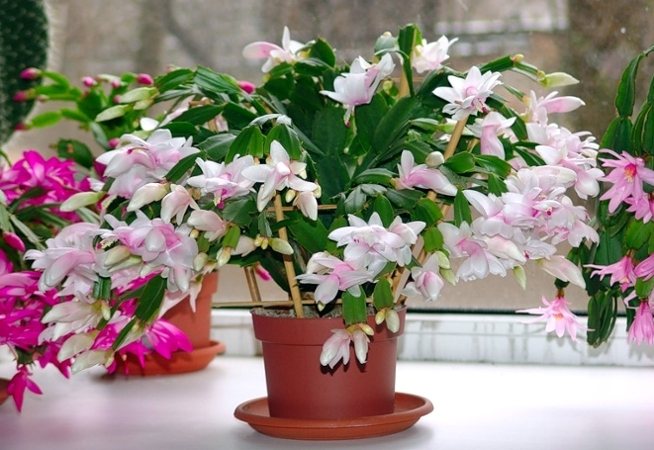

- The upper part of the plant must be completely cut off, then cleaned of the leaves, and in the upper part it must be slightly split.
- For the scion, you will need a Decembrist sprout of two or three segments, this is quite enough.
- The lower part of the cutting needs to be slightly sharpened with a knife, and then inserted into the slot of the prickly pear or pereski.
- You need to insert a needle into the junction, and wrap everything with an ordinary plaster on top, for final fixation.
Usually, the scion also takes about two to four weeks, and it is worth taking care of maintaining the temperature at this time at a level of more than fifteen and less than twenty degrees Celsius. You can remove the needle and patch only when you notice that the plant is sprouting new shoots. It is imperative to remove all lateral shoots or leaves of the plant so that it can provide the grafted cutting with all the necessary nutrients. If everything is done as it should, then abundant flowering can be obtained in the very first winter, and this is a real miracle.
Soil and container
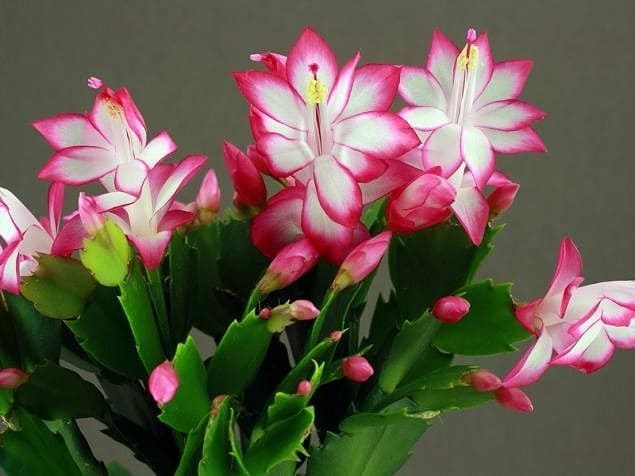

How to propagate a Decembrist at home is understandable. But what to plant a rooted stalk in? For planting zygocactus in a pot, ordinary soil for indoor flowers is suitable.
The best option would be a peat soil with a neutral balance. There should be no acidic or alkaline reaction in the earth. Vases should be chosen smaller. The root system of the plant is poorly developed, it does not need a deep container.
For a rooted cutting, a small pot or peat cup is suitable. The choice of a large capacity does not make sense, because over time, the flower will still have to be transplanted. Whatever the container for planting, the flowerpot is filled by a third with a drainage composition. It can be foam balls, small pebbles, expanded clay. The main thing is that excess water is removed, and the soil is not very wet.
Next, you should pour the prepared soil and moisten. A rooted cutting is planted in the soil. The sprout should be placed in the ground no more than a third of the height. The planted cutting is left in a lighted place, avoiding direct sunlight. The growth temperature of a young plant should be above 18 degrees Celsius.
You need to take a small container for planting sprouts; plastic cups are well suited. This volume of the seedling will be enough for a year of growth for the normal formation of the root system. Then it can be planted in a new pot, slightly larger than the old one. In a container that is too large, the plant will begin to rot. A pot for a Decembrist must, without fail, have holes at the bottom for water drainage.
Which land?
In the natural environment zygocactus lives on the branches of tropical trees or between rocks
... Such conditions presuppose free air access to the roots and good water flow.
To plant a Schlumberger with a shoot, you must follow the instructions:
Getting a cut of the stem
- For the purpose of reproduction, it is better not to use a plant that is too old. Examine Schlumberger. Choose a less dense area of the plant. Find the place where the young links end and the old ones begin. The stem section must be healthy, free from damage and consist of two to three segments.
- Break off or twist off a part of the stem with aerial roots with rotational movements. At the same time, hold the Decembrist with the other hand.
- Sprinkle the wound on the parent plant with charcoal or sand.
If you plan to grow a lush bush, you will need several cuttings.
... It is not recommended to cut off the appendages with a knife or scissors.
Preparing cuttings
Place the cutting on paper or a saucer and dry for two to three days in a dry, dark place.
Soil, drainage and capacity
To plant a plant, you need
:
- Prepare a new clean drain. It is allowed to take expanded clay, which was used for another culture. You need to rinse it, disinfect and dry it. Check the instructions for the purchased drainage: some types of special expanded clay must be saturated with moisture before laying. In this case, the drain should be soaked in clean, soft water beforehand. The maximum service life of expanded clay is six years.
- Prepare the soil mixture (read about what should be in the soil for the Decembrist and how to prepare it yourself).
- Disinfect the substrate using crushed charcoal.
- Treat the new pot with boiling water and dry.
Disposable cups can be used as containers.
Accommodation
Rooting
For rooting, you need
:
- After planting the cutting in the soil, you can cover it with plastic or a glass container to create a greenhouse effect. However, the plant successfully takes root even with free access of air under conditions of favorable temperature.
- Place the container with the handle in partial shade and keep at high humidity and temperatures from +15 to + 20 ° C. Protect from direct sunlight.
- Ventilate daily: remove the shelter for 30 - 60 minutes.
- Water with separated water at room temperature, in moderation, but regularly. Maintain the topsoil moist. Avoid stagnant water.
By the end of the first week after planting, the cuttings are producing their first roots. Full rooting occurs by the fourth to fifth week. - After the appearance of new segments on the process, remove the greenhouse. Now you can transplant a young plant into a permanent pot with nutritious loose soil (read how to properly transplant a Decembrist at home).
Rooting cuttings can be done in water
:
- Place the appendage in a container of warm water so that only half of it is immersed in the water.
- Top up regularly when evaporating. If the liquid turns yellowish and thick over time, it has deteriorated. In this case, the cutting should be rinsed and placed in a clean container with new water.
- After 7 - 14 days, the root system appears. You need to plant the scion in the ground.
Seeds
You can use the seed reproduction method for zygocactus. This option allows you to experiment with the color of the flowers. It is practically impossible to get Decembrist seeds at home, so you should buy them in a specialized store.
- Moisten the substrate in a container with settled water at room temperature.
- Sow seeds by pressing each one to the soil. You don't need to deepen.
- Keep at a temperature of + 23 ° C and above. Moisten the soil regularly.
- Seedlings appear at different times. The first - after 14 - 20 days. If all the sprouts are required, it is necessary to continue to moisten the soil. The rest of the seeds can germinate even several months after sowing.
- After three months, sprouts with two to three segments can be planted in separate pots.
The Schlumberger landing is not particularly difficult. You can choose the most popular method - cuttings, or purchase seeds from a flower shop. The shoots easily take root at home, and the seeds have a high germination capacity. The main ingredients for success are good planting material, suitable soil and proper care.
If you find an error, please select a piece of text and press Ctrl + Enter
.
The Decembrist is considered one of the most amazing plants and is often referred to by flower lovers as "blooming cactus". Outwardly, the Decembrist is not at all like, since it does not have thorns inherent in them, adores water and does not like excessive sunlight. Florists love this plant for its violent and beautiful flowering, the period of which comes before the New Year. Reproduction of the Decembrist at home is a fairly simple process.
Decembrist is one of the most beautiful plants during the flowering period. The flower got this name because of the time of its flowering, which occurs in December. In everyday life, you can find many other names for the same plant - Christmas tree, zygocactus, forest cactus, schlumberg. Brazil is considered the birthplace of the flower.
Budding usually begins in August and ends in November, and the flowering period can last up to two months. The Decembrist belongs to heat-loving plants, therefore, it is not able to tolerate temperatures below 15C.
Conditions for flowering
The Decembrist is not a capricious plant, but still loves living conditions close to natural. And this is a warm and humid climate of tropical forests. In order to create conditions close to the family, the Christmas tree can be placed on the windowsills on the east and north sides. It is good when it does not bloom. With the beginning of flowering, it is better to relocate the wanderers to the southern windowsill, if there is one. In this case, it is worth shading the handsome man.
Special attention is paid to newly planted shoots. Young growth should be turned regularly to avoid one-sided crown development.All summer, the Decembrist is watered moderately, but when the flowering time comes, the watering should be increased.
The soil in the pot must be constantly moist. If it is difficult to maintain the condition of the soil by systematic watering, then you need to take care of its moderate drying. To do this, a layer of perlite or any of the substitutes is poured over the fertile soil. Such a technique will prevent the soil in the pot from drying out.
You need to water the handsome man only with warm water. This rule remains unchanged even in the hot season. They begin to feed the Decembrist in early spring. The first feeding is carried out in March. Any mineral fertilizers will do.
In the spring, the plant is fed only three times: in March, April and May, once every four weeks. During the active growing season, the amount of dressings is increased up to twice a month. With the onset of autumn, fertilizers are completely excluded. A high nitrogen content can cause irreparable damage to the flower. An excess of this mineral leads to root rot.
Growing a cuttings in a substrate
The broken off leaves are dried, leaving them for two days on the windowsill and darkening, and then planted in the substrate. You can deepen the cutting into the soil by half of one segment. Cover the top with a glass jar or plastic bag. Once a day, the greenhouse is ventilated, and the air temperature is maintained at about 20 ° C.
When roots begin to form on the Decembrist, this will be noticeable in its appearance - freshness will return to it again, and it will begin to form new shoots. At this time, the shelter can be removed, and after a month, when it is clear that the plant has grown, it can be transplanted into a larger pot in fertile soil.
Favorable conditions
Unlike all cacti, the Decembrist has no thorns, belongs to moisture-loving plants and does not need abundant lighting. The Christmas tree has flattened branches, consisting of segments, at the tip of which buds appear. They can be of very different colors: from cream and light pink to dark red. But the most popular are zygocactus with crimson flowers. The root system of the plant is rather weak, but it has the ability to quickly recover and form full-fledged roots.
Rooting
Cuttings can also be rooted in water. To do this, it is necessary to put the appendage in a container with settled warm water. This should be done in such a way that only half of it is submerged in the water. If the liquid evaporates, it must be topped up regularly.
If the water becomes viscous and yellowish over time, it has deteriorated. In this case, the cutting must be thoroughly rinsed and placed in a container with clean water. After a week or two, the first roots appear. After that, you can transfer the Decembrist to the ground. You already know how to plant it. Then it is cared for like an adult plant.
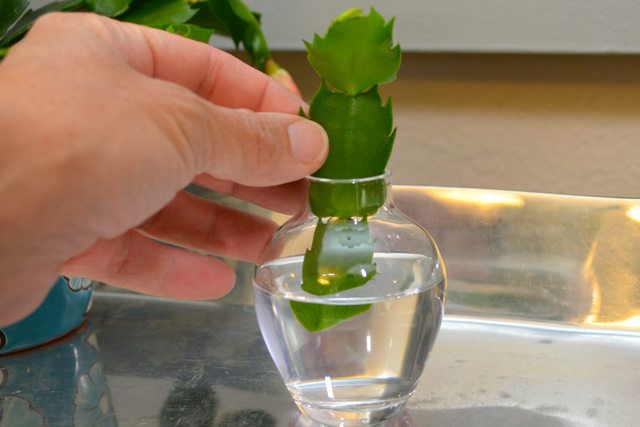

Watering rules
Home care involves maintaining high humidity. The Decembrist must be systematically sprayed. A tropical cactus loves warm rain. Why not please him with water treatments.
The pot with the plant is placed in a bathtub, after twisting the flowerpot in a plastic bag so that the earth in the pot does not get wet. After preliminary preparation, the plant is watered with warm water from the shower. In the cold season, during the flowering period, the zygocactus needs less a humid atmosphere. But excessive dryness harms him. On an overdried plant, buds quickly fall off, and it blooms less.
The Decembrist is a good decoration for an apartment. While home care can take some effort, everyone can do it. Even a novice florist can plant and grow this beautiful plant. If you follow the simple rules, then for three decades a luxurious native of the tropics will delight the owner with exquisite flowers all winter.
Main problems
When breeding Decembrist, a number of problems can arise, despite the ease of reproduction and good survival rate. To solve many of them, it is enough to have an idea of the possible reasons for the appearance of difficulties in reproduction.
The most common reason for the wilting of the cuttings or leaves of the Decembrist is the appearance of a fungal infection:
- late blight;
- phytum.
If a fungal infection is excluded, then you should look for the reason in non-compliance with the rules of care. The plant can wither when the root system is malfunctioning due to cold watering or excessive concentration of fertilizers. The plant should be fertilized with a complex of liquid dressings once a month from April to October. It is recommended to do the following:
- starting from the third week of September, watering completely stops, no fertilizers are applied to the soil;
- in November, the pot is placed on a light windowsill and the plant begins to water, starting with a small amount of warm water;
- after the restoration of plant growth and the appearance of buds, the plant cannot be moved to another place.
Falling leaves can be caused by various reasons. The most common are:
After identifying the true cause of leaf fall and eliminating it, the problem can be solved and the plant can acquire a healthy appearance in a short time. Decembrist is resistant to various types of diseases, but improper care can cause them to occur. The most common pathway for fungal diseases is soil contamination. When infected with a fungus, the Decembrist has the following symptoms:
- pallor of leaves;
- the presence of a grayish tint in the leaves;
- withering;
- falling off of individual segments.
To combat the disease and its prevention, the following drugs are used:
- Topaz;
- Vitaros.
For successful and abundant growth, it is enough to adhere to a number of simple recommendations:
Florists adore the Decembrist for its absolute unpretentiousness and ease of reproduction at home. The plant is able to withstand the absence of watering for three weeks.
Have you ever seen a cactus that loves water, cannot stand the sun and is not prickly at all? - an amazing house plant - belongs to the genus of cacti. The Decembrist differs from most indoor plants, in which the dormant period occurs in winter, in the flowering period - inflorescences appear on it on New Year's Eve. If you want your house to bloom with bright colors on winter holidays, start growing a zygocactus, especially since the reproduction of a Decembrist is a rather simple process and does not require special knowledge.
Follow-up care
Young plants require an annual transplant as they grow faster. It should be carried out in early spring. Decembrist withstands transplants well and his condition after them does not worsen. Adult flowers are transplanted every 3-5 years, you can only replace the top ball of the soil.
Taking care of young shoots is the same as for mature bushes. Watering is carried out with settled warm water. The plant is sprayed with the same water, especially the flower needs it at low humidity in the room and high temperature. If the processes have not yet fully formed the root system, and buds have begun to appear on them, they must be removed. Otherwise, the Decembrist will spend all his energy on flowering, and not on the formation of roots.
How to propagate the Decembrist Schlumberger, see the next video.
Landing
So, we have completed all the preparatory work, and it's time to find out how to plant the Decembrist's offshoot. In a container that is one-third filled with drainage, pour the soil mixture up to half the height of the pot. Compact the soil a little and water it well. Make a small indentation in the center.If you want a lush bush, plant several cuttings, making indentations according to the number of cuttings.
The lower tip of the rootless cutting is treated with "Zircon" or "Kornevin". It is planted as if it were on the ground. If the cutting has roots, they should not be deeply buried - the depth should be at most one centimeter.
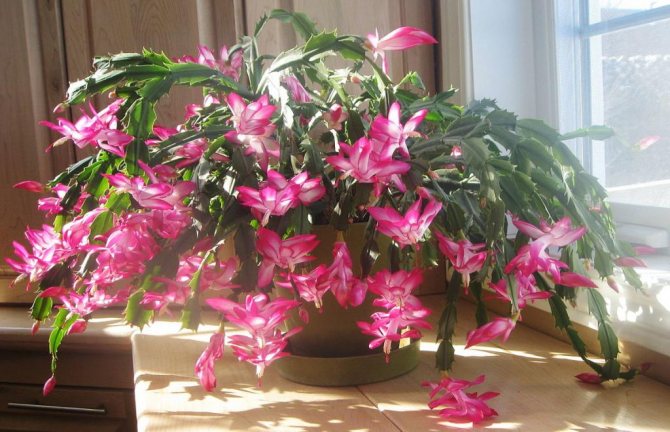

What is the best rooting container?
By propagating the Schlumberger with cuttings, you can get a new flower, while retaining all the specific features of the mother plant.
During flowering, the Decembrist should not be disturbed and take material for breeding. The most suitable time for grafting is the beginning of spring, when the flowering period of the zygocactus ends and the growing season begins.
If it was not possible to separate the stalk in the spring, it can be taken in the summer, when the bush is forming.
Zygocactus has a small and weak root system, especially when it comes to a very young plant. In addition, after deep rooting of the cuttings, they must be transplanted into soil with a more nutritious composition, therefore, a large capacity is not required for rooting. You can use plastic cups or small flowerpots, with a volume of about 150-200 ml.
At the bottom of the container used, there must be drainage holes, and immediately before planting the cutting, it is necessary to pour a drainage layer into it at least 1/3 of the height, which can be expanded clay, perlite, vermiculite, broken brick or small pebbles.
Choosing a stalk
A very old plant should not be used for propagation. Examine the flower carefully, choose a less dense area. Find the place where young segments end and old ones begin. The shoot must be healthy, free from damage and consist of at least two leaves. Unscrew or break off part of the stem with a rotating motion. It is good if it has aerial roots, but do not be discouraged when they are not. In this article, we will tell you how to plant a Decembrist process without roots.
Hold the mother plant with your hands while separating the stalk. Cover the wound on the flower with sand or charcoal. If you dream of growing a lush Decembrist bush, then use several cuttings. Do not use scissors or a knife to obtain them.


How can you tell if a shoot is ripe?
It is not difficult to choose a shoot suitable for grafting. It is necessary to carefully examine the Schlumberger and find long, weakly branched or not branched stems at all. At the same time, it is possible to pinch the stalk of the zygocactus so that it begins to branch, and to separate the stalk for reproduction.


You should choose strong and healthy shoots, with good turgor, without scratches, cracks and other mechanical damage on the sheet plates. It is desirable that they have aerial roots.
Shoots suitable for propagation should have at least 2, and preferably 3 segments. In some cases, it is possible to root even one leaf, but with a less predictable result. It also makes no sense to take shoots with 5 or more segments - it is inconvenient to work with long cuttings.
How to propagate a Decembrist with one leaf
This method can be considered as a variant of grafting. Segments are cut from old branches, they must be healthy, rather large, without mechanical damage. The preliminary preparation of planting material is no different from the rooting process.
Unless it is better to plant it in the ground, because when rotting in water, the leaves will simply have to be thrown away. Greenhouse conditions are created immediately by covering the container with the Decembrist with a glass jar, plastic bottle or glass.
What kind of soil is suitable for planting?
The soil for planting cuttings should be light and loose. You can buy ready-made cactus potting soil or universal peat-based potting soil from your flower shop.You can also prepare the soil mixture yourself. To do this, you need to mix in equal proportions:
- leafy ground;
- sod land;
- peat;
- river sand.
To improve its structure, perlite and crushed sphagnum moss should be added to the resulting soil mixture.
The main requirement for the soil is that its acidity should not exceed pH 5.0-6.5.
Planting the Decembrist in the soil
For planting a zigo cactus, light soil made from equal parts of sand, peat and fertile garden soil is suitable. The pot is selected not too high, but wide, so that several cuttings can be placed in it, and then a lush, beautiful bush will form.
The bottom of the pot is filled with expanded clay of medium fractions with a layer of 3 cm, and the rest of the space is filled with soil mixture. A hole is dug in the center of the pot, and if there are several seedlings, then by the number of cuttings planted, and shoots are placed in them. The soil is watered abundantly until water begins to seep from the drainage holes, and when it drains, the pot is placed in a pan and placed on the windowsill.
Difficulties and problems of cuttings
When grafting, you can face some problems:
- the segment leaves turn red - this is probably due to direct sunlight on the young plant;
- the stalk withers - this is due to a violation of the rules for caring for the plant (watering and spraying with cold water, an excess of fertilizing) or the development of a fungal infection;
- the stalk rots - most likely the problem is an excessive amount of moisture, it is necessary to remove the stalk from the soil, remove the damaged parts, dry it for 48 hours and plant it in new soil, reducing watering.
Preparing cuttings
The separated parts of the shoots are laid out on paper or cloth and dried for two to three days in a dark, dry place. Prepare drainage. You can use expanded clay, previously used for another crop. In this case, it is washed and dried. Carefully read the instructions for drainage: some species need to be saturated with moisture before laying. The drain is soaked in soft clean water. It is important to know that the maximum term of use of expanded clay is six years.
Prepare a DIY potting mix or a ready-made store-bought mix. The soil, prepared by yourself, must be disinfected with boiling water or by placing it in a preheated oven or microwave for ten minutes. Heat a new pot with boiling water and dry it. You can use disposable plastic cups as the first container.
Young plant care
- To maintain a stable microclimate and a high level of humidity after planting the cuttings in the soil, you need to create a greenhouse effect by covering the cuttings with a jar or bag.
- Cuttings must be placed under diffused lighting at a temperature of about 15-20 degrees. The greenhouse needs to be aired daily for 30-40 minutes, the condensate that appears must be removed.
- The soil should not be watered abundantly, it should be moderately moist, watering can be carried out only after the topsoil is completely dry, otherwise the cuttings will rot. It is best to replace watering with spraying with warm, soft water. Until the complete rooting of the zygocactus, the containers with cuttings cannot be moved.
- When new segments appear on the processes, they must be transplanted into a flowerpot from a small plastic glass. It is necessary to transplant by the transshipment method, leaving an earthen lump around the weak roots.
The Decembrist has a superficial root system that does not need deep planting, so the flowerpot should be low and wide, always with drain holes.
If the rooting of the zygocactus took place in a flowerpot, the flower should not be disturbed for several months, until roots appear in the drainage holes, speaking of filling the soil.
After transplanting, the Schlumberger needs to be placed in the shade for 10-14 days for the flower to recover from stress. During the adaptation period, watering should be replaced by spraying. After that, it is advisable to take out the rooted cuttings in partial shade on the balcony or veranda. Fertilizers can be applied only after 2-3 months.
How does the Decembrist propagate by seeds?
At home, this method is rarely used, since the main difficulty is obtaining planting material. For pollination to occur and seeds to form, you need to have in your collection at least two types of zygocactus with different colors. In addition, they should bloom at the same time. If everything matches up with you, this is a great opportunity to feel like a breeder and breed a new species.


It takes a long time to wait until the seeds ripen, at least 6 months. And they are contained in an oblong box, resembling a rosehip fruit, inside the pulp.
The seeds of the Decembrist are sown directly on the surface of light soil, after washing them in a solution of potassium permanganate. It is not necessary to cover it with earth and cover it with foil - the crops will germinate anyway. In the first year of life, the plant should be dived every 3 months. One-year-old cacti can be transplanted twice a year.
Video about the reproduction of the Decembrist by cuttings and grafting
Before planting, you need to choose which pot to place the flower in.
... Therefore, it should be remembered that zygocactus has a superficial root system that is extremely sensitive to adverse conditions.
As a result of overheating or hypothermia, gulf, acidification of the soil, the roots of the plant rot and die off.
Photo
Below you will see a photo of which pot the plant needs:
Dimensions (edit)
For planting, you need to take a low wide pot
... In a container that is too deep, the roots do not reach the bottom, so moisture may remain at the bottom of the pot. This causes waterlogging of the substrate and rotting of the root system.
When choosing a pot for a transplant, the appropriate size is determined by placing the old flowerpot in a new one. It should completely enter, leaving a little free space between the walls - no more than one centimeter.
An excessively spacious pot will lead to active growth of green mass and roots, which will interfere with the flowering of the plant.
Material
Decembrist can be planted in both ceramic and plastic containers
... In this case, the features of the selected material should be taken into account. Ceramics are natural and porous.
If it is not covered with glaze, oxygen passes freely to the roots, and excess moisture evaporates through the walls of the pot. This prevents such unpleasant phenomena as rotting of the root system and the development of mold.
The ceramic pot has excellent thermal conductivity
... However, in the process of removing the plant from such a container during transplantation, the roots that adhere to the inner walls can be damaged. Another disadvantage of this material is the formation of salt deposits on the surface of the flowerpot, which clog the pores. Getting rid of salts is difficult.
The bright and colorful glazed pots have partially closed pores. Plastic is a man-made material. These flowerpots are easy to clean. The downside is the fact that the plastic does not have porosity, makes it difficult for oxygen to reach the roots and slows down the evaporation of moisture.
Excessively abundant and frequent watering leads to root rot
(you can find out how to properly water the Decembrist so that it blooms magnificently and is healthy). This deficiency can be corrected. It is enough to provide good drainage during planting and prevent waterlogging of the soil.
In a container intended for Schlumberger, there must be a drainage hole that will allow the water to drain freely.
Preparing for flowering
It is this stage that is rightfully considered the main one, since with proper care for the Decembrist, in compliance with all the subtleties and recommendations regarding the preparation of the plant for this stage, the flower will give an unforgettable bouquet of luxurious inflorescences. Amateur gardeners and beginners prefer to ignore the preparatory work, which does not benefit indoor plants. The Decembrist will bloom with proper care, however, without preparatory work, there will be fewer inflorescences, their color will be less bright, and the flowers are not so lush. The plant is taken out into the street at the moment when the temperature outside becomes lower than that in the house, provided that such manipulations were not done in early spring. It is recommended to install the pot in the shade, providing shelter from wind and rain.
Watering stops completely. Contact between moisture and the Decembrist should be excluded for a while. The foliage may wilt slightly, but this is to be expected. In this state, the flower is maintained for a month. After the temperature has dropped below + 10 ° C, the pot is brought into the room and rare watering begins. At the same time, the number of buds can be significantly reduced, but this does not mean that flowering will not come. Special attention should be paid to lighting. By the end of September, the plant is placed in a place where it would receive sunbathing (not direct), no more than 10 hours during the day. From this moment, 50 days should be counted. It is after such a time period that flowering will begin.
So, you can easily influence the timing of flowering bushes. After the end of daylight hours (for a plant - 10 hours), the Decembrist should be provided with complete darkness. Even a small light source can shift the forecast date. Such manipulations are being done in order to prevent the plant from spending all its energy on the development of the root system and building up the next shoots. This will help to leave more energy for the buds. With the onset of November, the flower can be displayed in a permanent (familiar to him) place. If the pot is moved or rearranged, the buds will crumble. In order for the inflorescences to be brighter, the temperature regime should be observed, which will be + 17-20 ° С.
Temperature
The Decembrist should not be exposed to significant temperature extremes. The most comfortable temperature is + 18 ... + 25 0С. In order for the flower to bloom on time, in September - November it is advisable to take it out to cooler conditions, where the room temperature is 15 ... + 16 0С. During flowering, it should be brought back to a warm place.
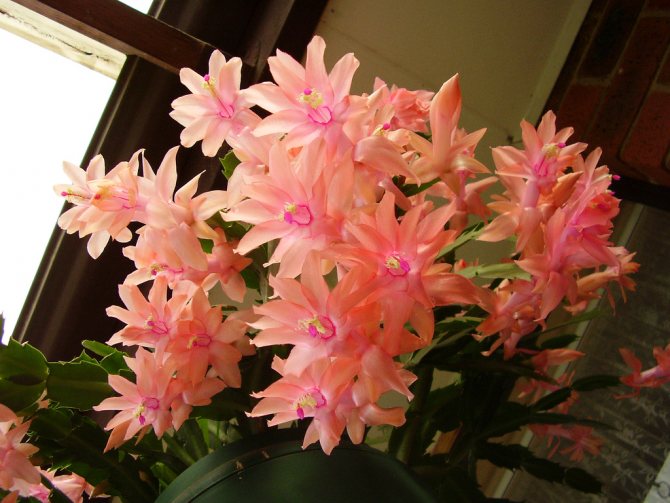

Features of the room Decembrist
The plant has a short, woody stem and segmental leaves, which consist of elongated parts with wavy or jagged edges, as well as fleshy bright green leaves. Flowers are funnel-shaped and can be of different colors. The buds are formed at the ends of the jointed leaves.
The birthplace of the Decembrist is the southern part of America, where the plant blooms in the summer. At home, hybrids of this species grow, which begin to bloom in mid-December, and if all recommendations are followed, they can bloom twice a year. In addition, more and more hybrids with two-color buds appear every year. The plant itself is quite large and reaches a large size. In its natural habitat, the flower grows on trees, so its leaves and flowers are directed downward.
The Decembrist has three subspecies - Truncated Schlumberger, Gertner and Buckley. Truncated is distinguished by long segmented leaves, as well as flowers with edges bent outward. Gertner subspecies has bright orange buds with sharp petals at the ends. Schlumberger Buckley enchants with its lilac blooms and segments with protrusions at the edges.
Pruning and replanting
To trim the Decembrist, you should choose a free day in June.All crooked, skewed and malformed shoots are removed. Thus, the plant will be able to form a beautiful crown, which will produce more healthy inflorescences. Pruners or scissors do not take part in the work done. It is more useful and less traumatic to gently twist diseased shoots. The transplant is carried out once a year with the onset of spring. Each subsequent container will be several centimeters wider than the previous one. A large container will lead to waterlogging, which will not benefit the plant. Older individuals are transplanted every few years.
No transplant is carried out during the flowering period. Otherwise, all the buds will crumble, and the subsequent flowering will come in a few years. A third of the tank is diverted to the drainage system. The rest of the space is filled with earth, with the addition of broken coal. The plant is removed from the old pot without haste. Weak loosening along the rim of the pot, followed by separation of the earth from it, will help speed up the upcoming process. The roots are cleaned of old soil and washed. After the Decembrist can be transferred to a new container, after straightening the root system.
At the end of the abundant watering, the pot is set in a permanent place. After the end of flowering, the buds will disappear. The pot is placed in a dark place and subsequent waterings are reduced. This will help the weakened plant recover. The pot is put on the same place in March. After that, a portion of new fertilizers is applied, while simultaneously increasing the number of irrigations.
Pot and soil selection
To obtain a healthy and strong flower, florists recommend choosing the right planting container and nutrient mixture. Due to the presence of a small root system, it is necessary to choose low pots with a large diameter. In specialized stores, you can buy pots made of clay, ceramics and plastic. Florists recommend giving preference to ceramic and clay containers.
Main condition - the presence of drainage holeswhich can be made by the grower or owner of the flower on their own. In the process of transplanting a plant, it is necessary to increase the diameter of the planting container.
The main signs of quality soil for the Decembrist:
- low acidity;
- loose structure;
- the presence of a drainage layer;
- high level of movement of water and air;
- the presence of perlite and bark particles;
- the presence of mineral and organic fertilizers.
When self-compiling nutrient soil, it is necessary to combine in equal proportions sand, leaf and peat soil, as well as add turf and humus... The introduction of fresh manure will negatively affect the development of the plant. To prevent the development of fungal and infectious diseases, it is necessary to disinfect the soil mixture. In the absence of the possibility of processing the land, you just need to add charcoal to the composition.
It is not recommended to use heavy and acidic potting mixes. In flower shops, you can buy ready-made potting soil mixtures for this type of indoor flower, which are of high quality and meet all established standards.
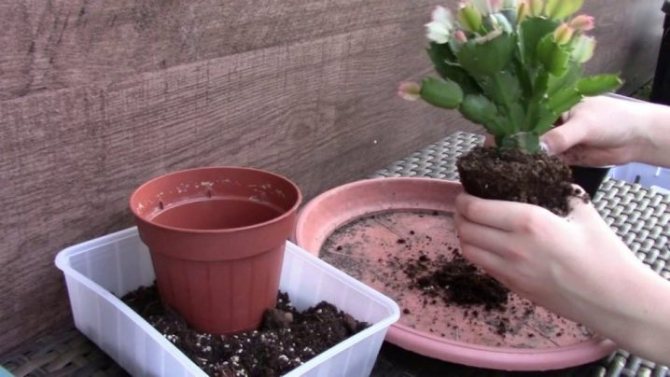

Care rules
In order for the reproduction of the Decembrist to bring a positive result, and the flower felt well in the house, it is necessary to organize conditions that would be close to natural. This is about creating a warm and humid atmosphere as well as plenty of sunlight.
If we take into account that zygocactus does not bloom in the warm season, then in the spring and summer it can be placed on the windowsills of windows facing east and north. In winter, it is recommended to place the flower pot on the south side. If you do not rotate it at all, then the bush will not be symmetrical, since the branches will begin to stretch towards the sun. Therefore, flower growers advise moving the plant every month. When growing a flower, it is very important not to disturb it during the budding period.When tying buds, the pot must not be rotated and rearranged to another place. If you move the Decembrist during the formation of buds, then the inflorescences will begin to crumble. It is not difficult to take care of the zygocactus. The main thing in caring for a plant is to maintain its habitual growing conditions.
How to raise a Schlumberger?
To get a good culture, it is important that planting and caring for the Decembrist is carried out with knowledge of all the nuances.
Novice florists often have problems with this flower. Therefore, it is worth dwelling on the features of growing a cactus in more detail. You can read about how to grow an orchid at home.
Reproduction of indoor Decembrist
A cactus of this type is propagated using cuttings. They are the extreme segments on a long shoot. It is not worth cutting off the twig. Better to break it off gently. The procedure is performed after the end of the flowering phase. During this period, shortening the shoot will not harm the culture. On the contrary, bud tying will occur with greater intensity on the shoot.
The broken off stalk is placed in water. After 2 weeks, roots will appear at the site of the break. And after a month, the plant is ready for planting in the soil. The stalk is buried in the substrate by half of one segment. The branch is covered with a plastic bag on top. A regular glass jar will do as well. Once a day, such a greenhouse is ventilated. Caring for the Decembrist at home, it is important to maintain the air temperature at +20 degrees.
Planting a plant in a pot
After a month, the cactus is transplanted into a larger pot. Use only high quality fertile soil. A mixture of garden soil, peat and sand will be ideal. All are taken in equal parts. The result is a fairly light soil. The pot must be chosen wide and not very high. Having planted several cuttings in it, you can form an unusual, beautiful bush. Expanded clay is placed at the bottom of the container. Next, the soil mixture is poured. Dig a hole and place a stalk in it. After planting, abundant watering is performed.
Proper care for the Decembrist at home
After planting, it is required to provide the plant with suitable growing conditions. It is especially important to care for the Decembrist in winter, during the flowering period. Protect the cactus from exposure to ultraviolet rays. Therefore, it is advisable to put the pot not on the windowsill, but in a shaded place. The temperature in the room should be maintained at a certain level: at least +2 degrees, maximum - +37 degrees. Optimally - from +12 to +16 degrees.
Irrigation is an essential care element. In the spring and summer, watered as the substrate dries. But in the fall, the regularity of this procedure is no more than once a week. With the appearance of buds, irrigation is made more abundant, the cactus is sprayed daily. The main thing is not to flood the plant, otherwise the root system will start to rot.


Feeding of the Decembrist is carried out in the spring-summer season. For this, special complex fertilizers are used. For active growth and good flowering, it is required to give preference to formulations that contain potassium, phosphorus and nitrogen. Since March, fertilized monthly with small doses of nutrients. In summer, there is an intensive growth of the stems. The plant during this period needs more frequent feeding. Nutrients are added twice a month. But starting from September, they stop fertilizing.
Treatment with fungicides will not be superfluous. After all, the disease of the Decembrist at home is not uncommon. Fungal ailments are especially annoying. Phytophthora, phytium, fusarium - all these fungal infections penetrate the culture from the contaminated soil. The flower looks gray, pale, withers. To combat these diseases, the drugs Vitaros, Topaz, Mikol, Baylon and Maxim are used. Sometimes, in order to fully restore the Christmas tree, it is necessary to remove the affected parts of the shoot.
Also, the cactus is often attacked by harmful insects. For example, a spider mite. It is impossible to do without spraying with special substances. Means of Neoron, Actellik and Fitoverm help to get rid of the tick.
Zygocactus should be pruned regularly. Excess shoots are removed in the spring. This procedure stimulates abundant flowering in the winter season. In addition, timely pruning is necessary to maintain the good appearance of the plant. Scissors are not used for such an operation. Remove shoots with your hands, gently making circular movements.
It should be noted that the Christmas tree is the type of cacti that should be replanted. This is done at the end of February, immediately after the end of the flowering phase. During the spring, the culture has time to take root and gain strength. The regularity of the transplant depends on the age of the cactus. For example, young plants are replanted annually. But as for adult representatives, this event is done with them every 5 years.
The Decembrist is a popular beautiful houseplant, devoid of thorns, which are characteristic of other varieties of cactus.
Many growers grow a similar culture. After all, the cactus is easy to care for. It blooms with unusual, vibrant flowers. Moreover, this period falls in the winter, when other indoor plants are already in a dormant phase. If you plant it correctly and create suitable conditions for the growth of a Christmas tree, it will delight with its beauty for about 20 years. After all, the Decembrist is a long-liver. A lot of useful information in the article:
When the beginning of the day started with good feelings, then the whole busy day feels more pleasant. Growing vegetation is quite a pleasant experience, which will give a good attitude not only to those close to you, but also to everyone around you. Flowers are a wonderful decoration for a sophisticated interior. Walking past a bright corner, you can't help but catch your eye on some amazing flower. And the thought immediately comes, maybe it is worth planting a flower garden?
Photo tutorial on reproduction of zygocactus (Decembrist)
... Zygocactus (Zygocactus), known to us under the names: Decembrist, Schlumberger, Rozhdestvennik, Christmas cactus or Barbarian color propagates by cuttings consisting of 2-3 segments. Usually, cuttings of Zygocactus root perfectly, regardless of the weather outside the window, however, the ideal period for plant propagation is April-May, when the plant has already bloomed.
We take the zygocactus plant and carefully inspect for the presence of several segments that have let out small roots. As a rule, each adult plant has similar segments. To breed a separate lush bush, you will need several of these cuttings. It is recommended to examine the less lush part of the plant, because with the help of cuttings, the Zygocactus rejuvenates, and therefore, it will begin to give new shoots more intensively and bloom more abundantly.
After we have outlined a few cuttings, we are preparing to separate them from the shoots. For these purposes, we only need hands. It is highly discouraged to use a knife, scissors, blade, scalpel and other cutting and sharp objects. You just need to take the intended segment of the plant from 2-3 extreme members, pinching it with your fingers, and start turning it along the axis, separating it from the shoot. With the other hand, you can hold the stem of the bush. Typically, cuttings separate quickly and easily from the cactus.
The separated segments must be dried for several days. To do this, cuttings can be placed outdoors in a container until a vitreous film appears in the separation area. To improve the drying process, the area of the future root system can be sprinkled with sand or charcoal. But this is optional. When the cut is covered with a glassy film, the planting process can begin.
Preparing the soil. As a rule, Zygocactus grow more successfully in soils saturated with peat.To do this, you can use a universal substrate with soil acidity of 5.5-6.5, or you can prepare the soil yourself, based on the following composition:
Some growers grow Zygocactus exclusively in the peat itself. The main thing is that the soil is light and breathable in order to avoid infection and pests. It is recommended to drain one third of the height of the pot.
We take a pot or temporary container in size not much larger than the expected size of the cactus root system. As a rule, the root system of Zygocactus is poorly developed, so a small capacity is required to begin with. Fill the pot with soil and lightly crush.
Dried cuttings are rooted in moist soil, slightly deepening. To create an abundant bush, several cuttings are planted in one pot at once. If reproduction is being carried out for someone or a permanent house for Zygocactus has not yet been purchased, you can temporarily plant the cuttings in a disposable container. As a rule, there are no problems with rooting.
The cuttings can be covered with a jar or plastic wrap, but the plant should be regularly ventilated. The new Zygocactus bush should be placed in the shade, adhering to a temperature regime in the region of 15-20 degrees plus Celsius. Moderate soil moisture is recommended for successful rooting of cuttings.
The ideal soil option for the Decembrist is peat soil, or a soil mixture of sand, leafy earth and peat. However, the Decembrist also feels great in the black soil, personally tested (he collected land from the garden in a bowl and roughly shoved a poor plant there, now it blooms and smells both literally and figuratively). It is better to prepare the soil for transplanting in advance, even in the fall, since transplanting is usually carried out in late winter, or early spring, as soon as the "Decembrist" stops blooming.
How to propagate a Decembrist flower?
There is only one way of reproduction of the Decembrist - by cuttings.
Cuttings for this can be obtained in several ways:
- cut off a stalk from the stem, consisting of two, and preferably three links. This should be done so that the cut is as thin as possible. But it is better not to use this method;
- Having carefully examined your flower, in the place where young, still immature links end and old ones begin, there are often aerial roots. Here you can simply break off or unscrew a part of the stem with roots with rotational movements;
- take part of the stem that has fallen off the main plant.
Rooting of cuttings can be carried out simply by putting them in water, until roots form on them.
Reproduction of the Decembrist flower can be carried out throughout the year, this does not affect the rooting of cuttings, since it does not have a pronounced dormant period. To create a large lush Decembrist bush, it is fashionable to plant several cuttings in one pot at once.
Flowers on the Decembrist after reproduction can appear even in the same year, even on a plant consisting of several links.
Decembrist flowers - care and reproduction
These unusual flowers have many names: zygocactus, Decembrist, Christmas cactus, Schlumberger. They belong to epiphytes, which means they prefer to settle on other plants and eat at their expense. The birthplace of the Decembrist is Brazil. That is why, when summer is in full swing in his homeland, and we have winter, the Decembrist opens its flowers. Caring for him is not at all difficult.
Pot for the Decembrist
The root system of the flower is rather weak and it cannot take root deeply. Therefore, the pot should be shallow and wide.
Soil for the Decembrist
Before backfilling the soil, fill a third of the pot with drainage. The Decembrists prefer peaty-sandy soil. You can add pieces of broken brick. Fill the drain with a 1–2 cm layer of earth, and on top of it a layer of ash or activated carbon.
Where to put the Decembrist
In our latitudes, the Decembrist flower is an indoor plant. The Decembrist prefers bright, slightly shaded places that are not flooded with bright light. If you put it in a dark place, then it will not bloom. During flowering, it is better to transfer it to a brighter place, but direct sunlight should be avoided. Prefers a temperature regime of 16-20 ° C. At the end of October, it must be placed in such a place so that sunlight falls on it for less than 10-12 hours, and the temperature is cool, but not lower than 10 ° C. This will help the buds to form.
How to water the Decembrist
The Decembrist is watered weekly when the topsoil begins to dry out, but do not allow it to completely dry out. Water for watering the Decembrist should be warm and preferably boiled, because the Decembrist does not tolerate lime well. In summer, the zygocactus is watered more often, and from autumn, when the flower begins to prepare for flowering, watering should be more rare.
Popular varieties
Over the years of selection of the Decembrists, and it all began in the 80s of the 19th century, many varieties of the plant were bred. The most common are:
- Golden Fever or Gold Rush
got its name for the huge flowers of bright yellow color. - Malissa
- white flowers (
on the picture
). - Sunset Dancer
- multi-row flowers of orange color. - Dark Eva
- white flowers with a pink-crimson border. - Samba Brazil
- large yellow-red flowers. - Polka Dancer
- large lavender-lilac flowers. - Beach Dancer
- a rare salmon color with an orange border and a white flower tube.
Most often there are two main varieties of Decembrists on window sills, the reproduction of which is very easy:
- Schlumberger Buckley
lilac-pink with large symmetrical flowers. - Trunkata
with many color options.
Lighting
This cactus begins to bloom only with a decrease in daylight hours. The signal for stopping the growth of green mass and the beginning of the formation of flowers is a short daylight hours. If it is still long, then the flowers may not be expected. Therefore, in winter, the plant absolutely does not need additional lighting.
In summer, exposure to direct sunlight leads to:
- stopping the development and growth of zygocactus;
- yellowing and folding of leaves;
- death of the plant.
Possible problems
Reproduction of zygocactus by cuttings gives a high percentage of rooting, but problems may arise with a young plant:
- Segment leaves turn yellow and wither - the plant may be in direct sunlight.
- Withering of the cutting Is a manifestation of a fungal infection or improper care. Over-watering and using cold water will cause root rot. One of the causes of the disease is an excess of fertilizers. In this case, it is necessary to replace the substrate.
Zygocactus cuttings that take root in March bloom in the first year of life. In December, a flower appears on the bush. If you find small buds at the edges of the segments, stop moving the plant. Leave it alone for the entire flowering period, otherwise the Schlumberger will shed its petals. The Decembrist is a long-liver among indoor plants, an unpretentious cactus decorates a room for 15-20 years.
Scion method
What is its peculiarity? As mentioned earlier, there are two main methods for propagating the Decembrist flower. We took a closer look at cuttings. There is also a vaccination method. However, for a beginner, this option is not suitable, since it is rather complicated. For experienced flower growers, the scion will not cause any particular difficulties. For grafting, you need a plant that the Decembrist will plant on. Usually prickly pear or prickly prickly pear is used for this purpose. The top of the plant is completely cut off and leaves are removed. It will also need to be slightly split at the top. For the scion, you need a small Decembrist scion.The lower part of the cutting is slightly sharpened with a knife, and then placed in the prepared slot. For final fixation, a needle is placed in the place of the joint and slightly wrapped with a plaster.
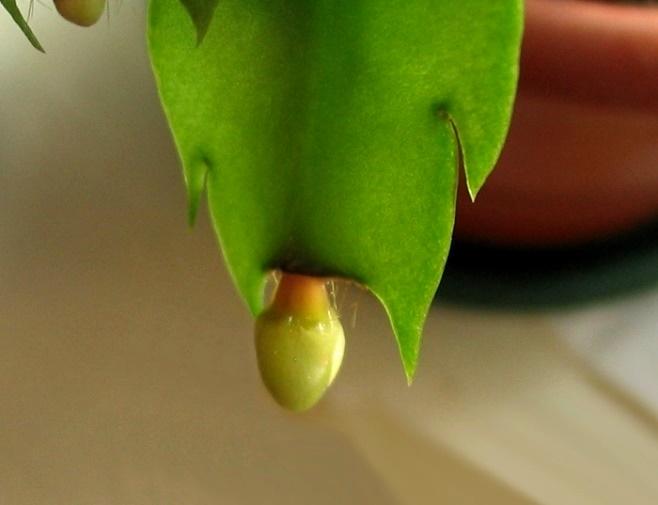

The graft usually takes two to four weeks. While the plant is adapting to new conditions, it is important to maintain the temperature at 15-20 degrees Celsius. It will be possible to remove the needle and plaster only after the plant has sprouted new shoots. Be sure to remove all side leaves from the crop you are planting. Only in this way will she be able to provide the grafted cutting with the necessary nutrients. This method does not always allow you to get a good result, since it is rather difficult to propagate a Decembrist flower by the scion method.
Description and features
The Decembrist has flattened-segmented branched stems, which, as they grow older, change their stem, it stiffens. The flowers of the plant are multi-tiered, long-tubular with many hanging stamens located at the ends of the branches. They have a rich color - white, dark red, salmon, lavender, cream, orange-red, but the most common can be called raspberry.
The root system has its own characteristics, its roots are weak, and under insufficiently favorable conditions, they quickly die, but thanks to the "search" roots, they are able to quickly recover and develop a full-fledged root system - care when breaking off the stems from the roots consists in regular watering of the dug parts.
Thanks to the labors of flower breeders, new varieties of the Decembrist with flowers of an unusual color are born every year. Some of them are able to delight others with three flowering throughout the year. Learn more about the plant in the next video.
Diseases and possible pests
A Christmas tree can suffer from such fungal and bacterial diseases:
- Fusarium, which reports its appearance by the orange color of the shoots and damage to the foliage: it becomes soft and lethargic.
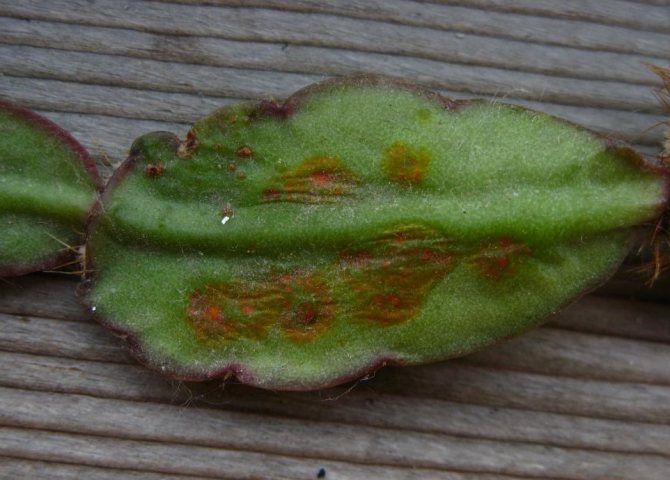

- Rot of cladodes. Leads to blackening of shoots due to deep lesions by fungal spores.


- Late blight - a disease causing the color of the shoots to change from green to gray. Damaged stems soon fall off, and fungal spores quickly reach the rhizome and provoke rotting.
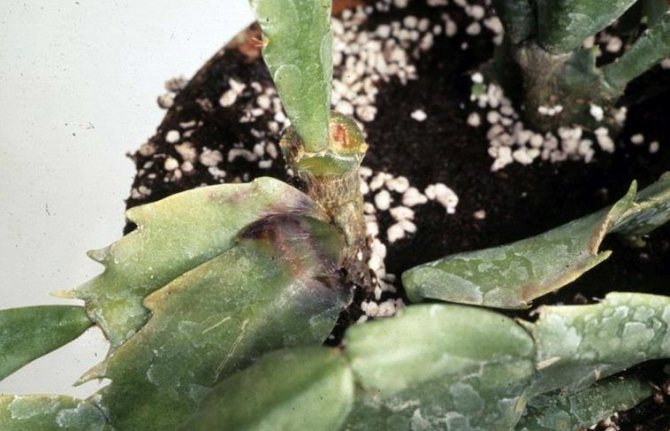

- Soft rot which is signaled by darkening of the stems, the appearance of mucus on them and rapid decay.
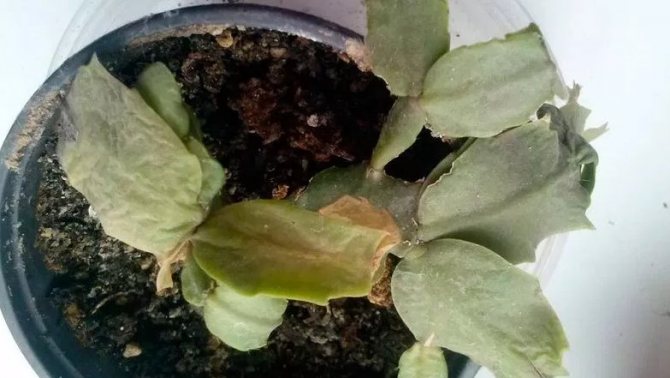

The use of systemic and contact fungicides will help to eliminate the listed diseases of a fungal and bacterial nature. So, the most effective will be the treatment of the Decembrist with solutions of "Fundazol", "Fitosporin", Bordeaux mixture, and you need to both spray and water the cactus, since diseases also attack the rhizome.
Important! During the preparation of solutions of insecticides and fungicides for the treatment of the Decembrist, strictly follow the instructions.
The main pest of the Christmas tree is considered to be a spider mite, for the fight against which the solution "Actellika" and "Fitoverma" are used. If the flower is attacked by mealybugs, then it must be sprayed with "Aktara".
High humidity is the main condition for caring for the Decembrists
To create it, it is necessary to regularly sprinkle the plant, water procedures under a warm shower, while covering the earthy lump with polyethylene to avoid waterlogging. In autumn and winter, the indoor Decembrist should be sprayed with caution, but excessive dryness can also lead to dropping of buds and flowers.
The soil for the Decembrist should not be heavy and dense. Peat mixtures or soil made from leafy or soddy soil, sand and peat with the addition of brick chips are well suited. At the bottom of the pot, drainage is required, which takes up a third of the capacity.
Answers on questions
The Decembrist is already an adult, but has never bloomed
In order for the Decembrist to bloom, he needs to withstand periods of vegetative growth and rest. Without this, there will be no flowering.
Why are flower buds showered from a bush?
After the Decembrist began to grow flower buds, it is not recommended not only to rearrange it from place to place, it cannot even be turned in relation to the light.
Hello dear guests and regular readers of the site "Private House Garden and Vegetable Garden"!
I am very glad that you ask various questions about the cultivation of certain plants in the comments. I try to answer some of the questions myself, if, of course, I have sufficient experience in growing a plant, and if there is no such experience or it is not great, I invite, if possible, those wonderful people who have been enthusiastically growing this plant for many years. ...
Today, an experienced florist N.V. Tishchenko is a researcher at the Saratov State Agrarian University named after Vavilov.
So the question is:
I really want to grow a Decembrist indoor flower, but, unfortunately, I don't know where to start, and what conditions should be created for this plant. How to plant a "Decembrist" correctly, are there any peculiarities?
Best regards, G. V. Sarycheva
To avoid confusion, let's immediately make it clear, does the "Decembrist" have any other name?
- “Decembrist” is a popular name, and in specialized literature “Decembrist” is correctly called “Zygokaktus”.
What are the features of planting and reproduction of these flowers?
To plant and then propagate the "Decembrist", you do not need a lot of effort. "Decembrist" is easily rooted by cuttings. In most forest cacti (or epiphytic), cuttings are carried out in spring and summer, cutting off several upper leaf-shaped segments or the apex of the stem. Before planting in the soil, epiphytic cacti do not need to be dried, unlike others. Rooted in water or river sand, a mixture of peat with river sand.
Do you often need to transplant the Decembrist?
It is recommended to transplant the Decembrist annually after flowering in the first three years. You do not need to take a pot that is too large, it should be slightly larger than the root system. Then the transplant must be done every two to three years. It is advisable to place drainage on the bottom of the pot, and it is better to use fertile soil with the addition of peat.
What temperature regime should be observed when growing a Decembrist?
In general, the "Decembrist" is not a thermophilic plant and the temperature during its cultivation should be from 18 - 22 degrees, and during the dormant period - from 15 to 17 degrees.
What other rules do you need to follow for good growth?
First, provide dry and cool conditions for these flowers during the dormant period (February, March), never move the flower pot after the buds appear, and harden the plants outdoors in the summer months. There are times when a plant bought in a store blooms profusely in the first year, and then, if grown incorrectly, does not bloom in subsequent years. The reason for this is that these plants need a dormant period for normal flowering. At this time, the temperature is lowered and watering is limited, and the plants are hardened in the fresh air. Some amateur flower growers do not know this. During the period of flowering and growth, the "Decembrist" needs fertilizing with organo-mineral fertilizers.
What kind of lighting does a Decembrist indoor flower need?
For the successful growth and development of the "Decembrist" you need a bright diffused light. With a lack of light, flowering will be weak.
How to properly water these flowers?
After the end of the dormant phase, when buds begin to form, watering must be increased. During the growth period and in the flowering phase, the watering regime is the same as for most indoor plants, that is, it is quite abundant as the soil dries up. It should be watered with rainwater or settled tap water.
And the last question. Should zygocactus be sprayed?
Zygocactus requires frequent spraying if the air in the room is dry.
Zygocactus, or Decembrist, is a cherished flower "thornless cactus" with bright pink buds. Incredibly chic during flowering and easy to care for, Zygocactus plant. The color range of the buds ranges from white to red.
As it is not called by the people: "Rozhdestvennik", "Schlumberger", "forest cactus" - but few call it a zygocactus. The name "Decembrist" stuck because of the flowering time - from November-December to the very end of January.
Schlumberger is the "official" name of the beloved Decembrist, given in honor of the French collector of cacti and other succulents Frederick Schlumberger (1823-1893).
According to the description of Schlumberger, it is similar to Ripsalidopsis, another woody cactus from the tropics of Central America. They differ in flowering time - Schlumberger - in December-January, and Ripsalidopsis - in spring.
Schlumberger or zygocactus is an epiphytic cactus native to eastern Brazil. Stems drooping, branching well, there are erect and dwarf forms. Grown in ordinary pots or suspended as ampelous plants.
The new hybrids are distinguished by the beauty and size of the flowers, the variety of color shades - the traditional red, as well as pink, orange, white and multicolored. The flowering period is 4-5 weeks.
Growing conditions
Decembrist is a branched flower that belongs to the cactus family and forms a large number of inflorescences. The natural habitat is the tropics. The plant has flat, jointed shoots with jagged edges. Distinctive feature - lack of thorns... Each shoot consists of several segments, the length of which can reach 5 cm. New segments appear on the tops of the old ones, forming long and delicate shoots.
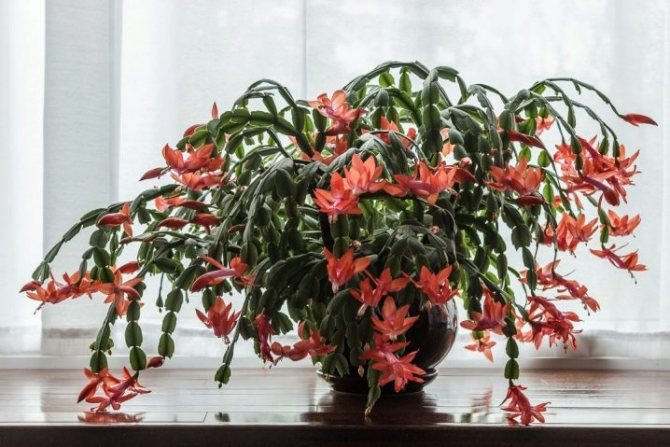

Schlumberger flowers (this is the official name of the Decembrist) are formed at the top of the shoot, the petals are in the form of tubules. The maximum size of inflorescences can reach 10 cm. The color range of flowers is in the range from pale pink to dark red... The structure of the buds depends on the type of plant.
For the full growth and development of a flower, it is necessary to create the most comfortable conditions for it. Despite belonging to the cactus family, the Decembrist is more demanding on the frequency of watering, soil type and lighting. A Christmas flower needs regular watering and protection from direct sunlight. Poor soil quality and overdried soil can provoke the development of diseases and plant death.
When choosing the location of the plant, preference should be given to windows that face north or east and have diffused lighting. Comfortable temperature conditions are in the range from +10 to +20 degrees. The optimum temperature for flowering in winter is +15 degrees. Experienced growers advise avoiding sudden temperature changes.
For uniform formation of new segments on all shoots, the pot must be regularly rotated relative to the window glass.
During the period of bud formation, it is strictly forbidden to carry out this manipulation in connection with the possible shedding of flowers. To increase the flowering period, it is necessary to lay small pieces of ice on the surface of the soil. The main conditions for the formation of a large number of buds are a low level of illumination in winter and the absence of an additional source of artificial light.
A high level of humidity is another indicator that affects the state of the Decembrist. To humidify the air, it is advisable to place containers with water or different types of tropical plants on the windowsill. The indicator of a comfortable humidity level is presence of aerial roots between the segments of the shoot.In winter, it is strictly forbidden to place plants near heating appliances or create artificial partitions between the battery and the indoor flower. To form a crown or obtain planting material, it is necessary to pinch off the shoots and in no case use cutting objects.
Helpful care tips
Rozhdestvennik is one of the few indoor plants that bloom in winter; its flowering period can last up to 3 months.
To achieve this, you need to take into account all the subtleties of care:
- During the dormant period, care is minimal, the place is cool, no additional fertilizing.
- Eliminate any temperature extremes, drafts. Decrease and increase the temperature gradually.
- Do not touch the pot during flowering. Turn towards the light during active growth.
- In winter, daylight hours are extended using artificial lighting.
- Flowering will last longer at temperatures up to + 16 ° C. It will be more magnificent if the container is narrow.


Zygocactus is a moody plant, but its long bloom and the appearance of large, bright flowers are worth the effort. A variety of varieties and hybrids (including Schlumberger) will decorate any collection of indoor flowers.
Plant features
The Decembrist has a number of differences from its neighbors on the windowsill. Most notably, it blooms when most are in their sleep period.
- It can be safely attributed to centenarians. If you give your indoor pet the right care, it will delight the eye for 20 years!
- During the budding period, the plant is more vulnerable than ever. That is why, at this time, try not to disturb him with transplants, turns and even permutations from window sill to window sill.
- The house flower does not like the bright sun, so do not put the pot on the west and south side.
- The Decembrist is “crazy” about fresh air. Ventilate the room more often, or simply grow it in the shade on a balcony, loggia or veranda.
- To quench your love of moisture, in addition to watering, spray from time to time with settled water at room temperature.
- Has an excellent property to grow. Under the right conditions, this plant tries to take up as much space as possible in order to take it away from competitors.
How to care?
When growing a Decembrist, you must follow a number of tips and recommendations of experts. Plant care consists of the following activities:
- moistening the soil;
- introduction of nutrients;
- creating a comfortable level of humidity and illumination;
- prevention of the development of diseases.
Basic rules for watering:
- regular moistening of the soil with warm water only through the pan;
- prevention of drying out and waterlogging of the soil;
- using only settled or rainwater;
- uniform soil moisture throughout the year;
- in the summer, spraying of the plant is mandatory.
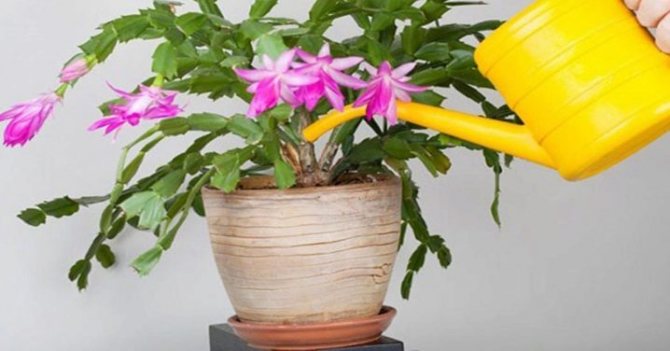

To feed the plant in spring and summer, it is necessary to use mineral fertilizers with nitrogen and phosphorus.
In autumn, experts recommend adding trace elements with potassium, and in winter (during the flowering period) organic additives will bring maximum benefit. Increasing the number of colors will help spraying the Decembrist with warm water with boric acid.
In the middle of summer, you can remove shoots and form the desired crown shape. Experienced gardeners use the pruned shoots to form new plants. Protecting the plant from diseases and pests is one of the main activities that will help to grow a beautiful and strong flower.
The most dangerous types of fungal diseases are fusarium and late blight. Signs of the development of diseases are a change in the color of shoots and the death of segments. The main reason for the appearance of fungal infection is the use of contaminated soil of poor quality. Special fungicides will help to cure these diseases. Ignoring this problem can lead to the death of the plant.
Various pests can also harm an indoor flower. Biologists identify several of the most dangerous insect species:
- spider mite;
- mealybug;
- shield.
To kill insects, it is necessary to treat the plant and soil with special chemicals.
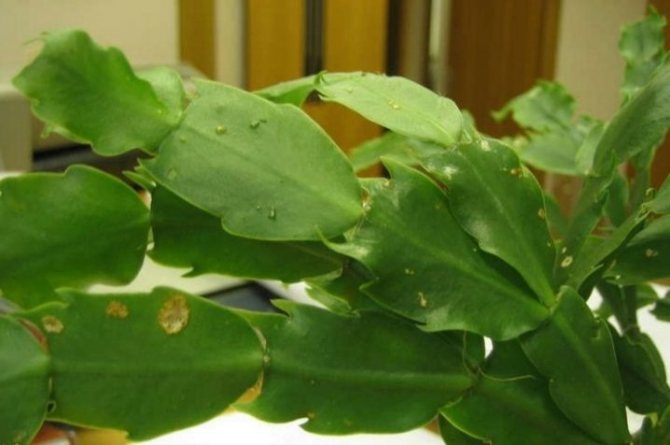

Failure to follow the rules for caring for the plant can provoke the following problems:
- shrinking shoots - non-compliance with the watering regime;
- reddening of the leaves is a consequence of exposure to low temperatures;
- drying out - the presence of a fungal disease;
- drying out and falling off of inflorescences - insufficient watering and the presence of drafts;
- lack of flowers - non-compliance with the rules of watering and the introduction of nutrients, as well as the level of illumination.
For many decades, indoor plants have been an integral part of living quarters.
Green helpers not only decorate the home, but also purify the air and heal the atmosphere.
Among the huge number of green favorites, florists recommend paying attention to the Decembrist, who can please all family members on New Year's and Christmas holidays with bright and beautiful flowers.
What is the Decembrist sick with?
The defeat of the scabbard (on the picture
). The first sign is the appearance of brown spots on the segments of the plant. In case of severe infection, it is necessary to wipe the leaves with an insecticide, if the measures are ineffective, the infected areas should be plucked.
Defeat by white worms. The control measure consists in removing them with a rag soaked in soapy water or treating them with a solution of karbofos at the rate of 40 drops per liter of water.
The Decembrist does not bloom. It is enough to place the flower for a while from September to November in a cold room, reducing watering and feeding, and in December to expose it to the sun and increase watering.
Decembrist, Zygocactus, Schlumberger, Christmas - these are the names of one very interesting cactus. Its uniqueness lies in the absence of thorns. This plant can be found in many homes. Popularity is due to its attractive appearance as well as ease of cultivation. But you need to understand that in order to get a healthy and blooming cactus, it is important to create suitable conditions for its growth. In order for the reproduction and care of the Decembrist at home to be correct, a number of recommendations must be followed. Which ones - the article will tell.
The Schlumberger or Decembrist plant belongs to the cactus family. Due to the ability to strengthen the roots behind the crevices of the bark, it grows in the wild on tree trunks.
The view of this culture is quite interesting.
The Decembrist cactus is characterized as follows:
What types are there?
Before you start growing a Decembrist, you need to decide on its type. At the moment, many varieties are known, which sometimes complicates the choice. Consider the options most popular among florists.
The following types of Decembrist are highly popular:
- Buckley.
It is characterized by multi-tiered flowers of a delicate lilac-pink tone. Shoots are light green, segmented. There are small projections at the ends. - Gertner.
The inflorescences are painted in a bright red-orange tone. In appearance, they resemble multi-tiered bells. The shoots are rather large. - Truncated.
The flowers are multi-tiered. The petals are bent back. The edges of the stems are serrated, sharp. There are such colors: purple, pink, light lilac and white. - Russeliana.
The flowers are bright. Located on a tubular greenish peduncle. There are a lot of petals and they are long. They can be pink, red or purple. Articulated stems. They can grow up to a meter in length.
Schlumberger grafting instructions
An indispensable condition when choosing a cutting for reproduction is a healthy mother plant. The scion must meet several requirements:
- Sheet plate without scratches, cracks and other mechanical damage.
- Choose a scion with good turgor.
- If some of the segments have air roots, give preference to them.
How to propagate Schlumberger by cuttings? Algorithm for preparing the cutting for planting:
- The selected branch of 2-3 segments is unscrewed from the mother bush. With one hand he turns clockwise, with the other hand he adheres to the branch.
Further actions depend on the rooting method.
Read about how to plant a Decembrist with a scion and in other ways, and from this article you will learn about whether it is possible to cut a Schlumberger and how to do it at home.
In the ground
To root the cutting, you need to prepare:
- Pot or plastic cup up to 200 ml.
- Substrate - special soil for cacti, bought in a store, perlite or a mixture made by yourself (read about what should be in the soil for the Decembrist and how to prepare it yourself, read here). The soil should be light and loose. For the mixture, leaf and sod land, peat, sand are used. The inclusion of perlite and ground sphagnum helps to improve the structure of the soil.
- A plastic bag or glass jar for a greenhouse.
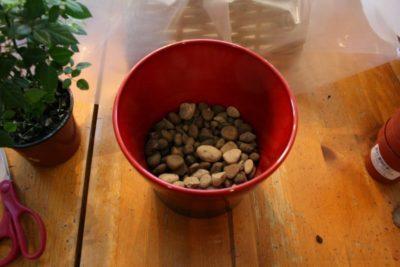

A drainage layer (1/3 of the volume) is poured onto the bottom of the pot, and the substrate is poured on top. Drainage is not required when rooting in perlite.- The soil is well moisturized.
- The prepared stalk is deepened by 5 mm.
2-3 shoots are planted in a large pot, one at a time in cups. To create a stable microclimate and maintain high humidity, the container with the handle is covered with a jar or bag.
The use of "Kornevin", a biological plant stimulant, will help speed up the growth of roots.... It is enough to dip the cuttings into the preparation before planting in the ground.
The branch of the Decembrist is placed in a warm (18-20 °) place with diffused lighting. The greenhouse is opened daily for 30-40 minutes of ventilation.
The emergence of new segments indicates successful rooting. If growth points are found, the shelter can be removed. Reproduction of Schlumberger in the substrate takes about a month.
In water
Consider how to root a Schumberger at home. Plastic cups (150-200 ml) or glass jars are used as a container for rooting a Decembrist. The water must be allowed to stand for at least a day so that chlorine impurities disappear. For rooting in water, it is convenient to use the long branches of Schlumberger. The liquid level in the glass is one segment. If necessary, add water.
The appearance of roots is clearly visible in a transparent container. They grow back in 1-2 weeks. During this period, it is necessary to monitor the state of the water. If it becomes cloudy, replace it immediately. This will avoid rotting the cuttings.
A few drops of "Kornevin" added to the water will accelerate the formation of roots on the Decembrist cuttings.
Having received roots longer than 2 cm, you can transplant the shoot into a pot. The procedure is the same as described above.
Capacity requirements - drainage, drain holes, loose, slightly acidic soil. The planted cutting is watered and left away from light. A week later, it is placed on the windowsill. The soil is moistened as it dries. The intensity of watering depends on the temperature and humidity level in the room (read here how to properly water the Decembrist so that it blooms magnificently and is healthy). The appearance of new segments means that the cactus has taken root.
Pruning
This cactus needs regular removal of excess shoots that appear in the spring. If this is not done, then in winter he will not be able to please with his magnificent flowering. Remove unnecessary shoots should be in June. Eliminate those that grow incorrectly and spoil the appearance. You can not do the work with scissors, you should grab the shoots with your hands and make circular movements to remove excess parts of the flower.
Anyone can handle the reproduction of the Decembrist.With proper observance of all the rules of care, this type of cactus will delight with its beautiful flowers for at least 15 years.
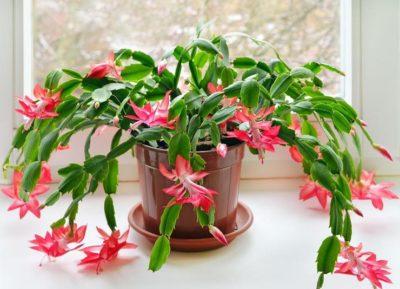

Decembrist (Schlumberger, zygocactus) is a plant that, if well maintained, pleases with lush flowering in winter.
To become the owner of a zygocactus, you do not have to go to the store. At home, it is not at all difficult to get a new plant on your own.
You just need to have material suitable for reproduction and follow the rules for planting Schlumberger. So, you will learn how to plant a flower correctly. Read more about planting the Decembrist in the article.
Transfer
If you want to transplant your green friend, you will have to wait until the last days of winter.
- Young flowers are best replanted once a year, after you admire its beautiful flowering.
- Adult plants should be pampered with similar activities no more than once every 4 years.
Regardless of age, it is recommended to carry out a transplant after the second decade of February.
Considering that in its homeland zygocactus lives on trees, its root system is superficial. Therefore, the pot should be small, but with a large bottom area. Fill a third of the container with drainage (ideally pebbles), and fill the top with ordinary purchased soil for cacti.
You can also manually create soil by connecting:
- Sand ¼ of the total amount of soil
- Sod land ¼ of the total amount of soil
- Leaf land ½ of the total amount of soil
Gently mix all the ingredients, and add a little crushed coal to prevent infection of the plant.
Possible growing problems and methods of solving them
Immediately after transplanting a young Decembrist, some problems with his growth may appear. So, the most common is the wilting of the entire flower. Most often this is due to the development of a disease that could appear at the time of weaning of the cuttings from the mother plant. It can also be triggered by decay of the root system itself, which often occurs due to excessive watering and improperly selected substrate.
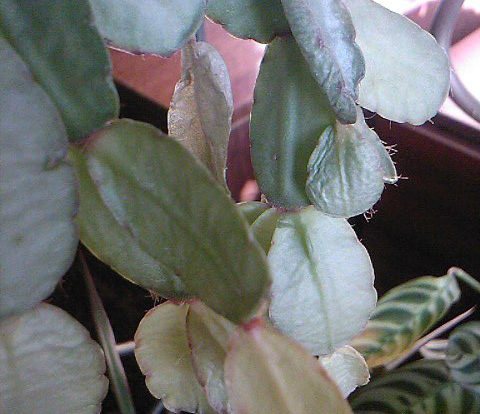

Withering flower
Watering with cold running water and over-fertilizing can lead to a loose stem. In order to eliminate such a problem, it is necessary to remove the plant from the pot, cut the damaged areas and plant the flower in new ground. When the entire root system dies, cuttings are cut from the flower for reproduction.
Florists often complain that the Decembrist does not bloom. This may be due not only to insufficient care, but also to the onset of a dormant period. This occurs when there is no rest before bud formation. During the dormant period, which lasts from September to the beginning of winter, watering and fertilizing are removed, and the pot is moved to a cool, dark place. At the end of autumn, the pot is put back in a warm place and all care is gradually restored.
Many gardeners, especially beginners, may be frightened by the sharp fall of the Christmas tree leaves due to tick infestation (insecticides are used for treatment). Also, the leaves fall off due to the presence of a flower in a draft, with sudden changes in temperature, dry air and insufficient fertilization. In such cases, it is very important to determine the cause of the problem and fix it.
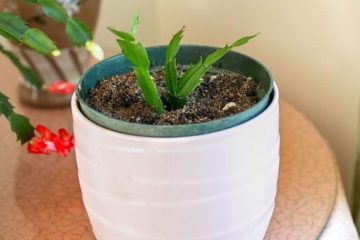

Sooner or later, everyone who grows a Schlumberger at home has a desire to propagate this beautiful plant. The most common way of reproduction of the Decembrist is vegetative, by cuttings. This method is popular for its simplicity and high rooting rate.
A stalk is the part of a plant that is used for vegetative propagation. After planting in the substrate, the cutting develops roots and buds and grows into a new plant. Cutting in all varieties of the Decembrist is the same.
How to water?
Excellent reproduction of the Decembrist at home is impossible without proper watering, which is the basis for its favorable growth. The watering regime is different for each stage of zygocactus development. During flowering, he especially needs water. Watering should be done regularly so that the soil in the flowerpot is always moist. But you cannot fill the plant either, otherwise the root system will begin to rot, the Decembrist will not bloom and will die. Water the plant with settled water.
This plant blooms from December to February. In order for the flowering to be abundant and lush at this time and after, water should be added as the soil dries. Watering should be carried out as soon as the top layer becomes dry. In the spring and autumn, it is extremely important that the soil does not dry out.
Summer is the dormant period of the cactus, when it needs to be watered as the soil is completely dry. But in hot weather, the flower must be systematically sprayed. There is another way - a warm shower. For this, jets of warm water are directed to the leaves of the Decembrist, the earth is covered with a film for this time.
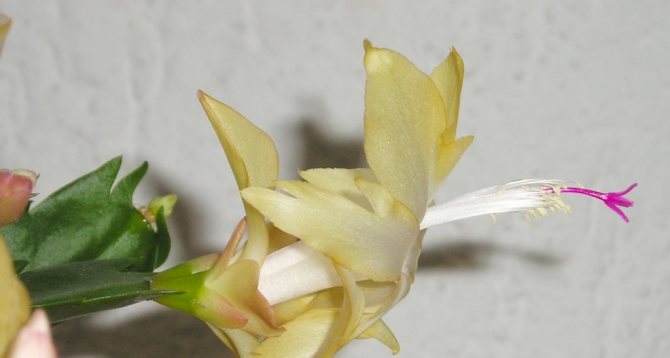

Transplanting an established shoot
After the cutting is rooted, it can be transplanted into a larger pot with loose soil. It is advisable to add a small amount of sand or compost. It is important not to water too much or allow it to dry out. You can use a spray bottle and spray the surface of the soil until the top is damp. As the cuttings grow, you can water them deeper. A small watering can or a small bottle will do this.
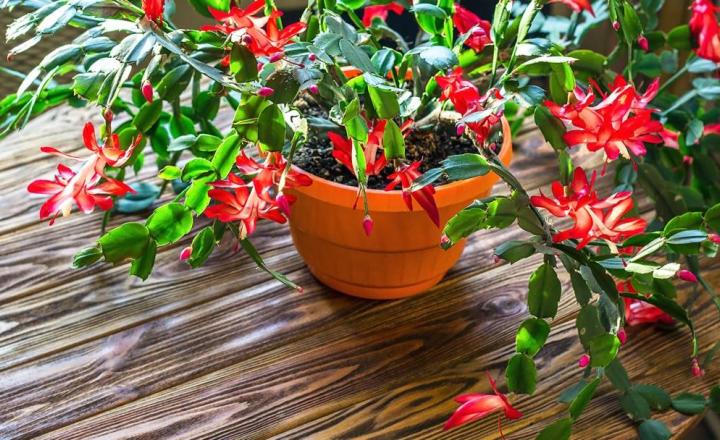

The answer to the question of when the Decembrist can be seated is simple - any time will do. Even the flowering period, but only if there is no fear of losing some of the buds. Experienced growers prefer to root the cuttings immediately after pruning, after drying them. But if you carefully unscrew the shoot from a flowering plant without turning the pot, all the buds should remain in place. After rooting the cuttings and the appearance of several new shoots, the young plant is pinched to stimulate the emergence of new shoots. With more branches, flowering will be more abundant.
Possible problems, tips


Experienced growers draw the attention of beginners to the following:
- It is better to combine Schlumberger cuttings with annual pruning. Then you will get several strong cuttings at once without disturbing the neat shape of the flower.
- To grow Decembrist from seeds, buy seed material at a flower shop. Hand-picked seeds are unlikely to have the same decorative qualities as the parent plant. However, this is the only way you can get new varieties of plants with the most unpredictable color of flowers. But this can take several years.
- If you cannot get zygocactus seeds, put two different Decembrists with each other during flowering. They are pollinated only in a cross way. It also requires the help of insects or an ordinary paintbrush.
- If the stalk began to wrinkle, this indicates the wrong conditions for its maintenance. He may be too cold, or he is standing in a draft. Check the lighting: it should be diffused, but abundant.
- If the Decembrist began to rot, then this indicates an infection of the roots. This is facilitated by waterlogging of the soil. The flower can be saved by letting the soil dry in its pot. Additionally, it must be treated with a 0.2% Fundazole solution.
- If young plants are affected by a mealybug, scabbard or spider mite, they should be treated with insecticides. For this, drugs such as Aktara, Karbofos, Inta-vir are suitable. After a week, the treatment should be repeated.
Decembrist is one of the most easily propagated plants. When growing plants vegetatively and providing proper care, you can wait for flowering in the first year.And thanks to the sowing of seeds, you can grow new species of Schlumberger and share it with friends and acquaintances in order to admire lush caps of bright flowers with a juicy and exotic color every winter.
Description
This amazing flower is called zygocactus. The plant is distinguished by the fact that in winter it does not enter a state of dormancy, it continues to develop and bloom. Reproduction of the Decembrist at home, as well as its cultivation, has a number of features.
The flower, like most cacti, appears in a leafless form. Foliage is considered to be a segmented fleshy thickening of the stem, in which the zygocactus stores moisture. Due to the weight and thin isthmuses between parts, its shoots are bent. Therefore, many growers grow this flower as an ampelous culture.
The growth and intensity of flowering of the zygocactus depend on the observance of these rules. Those who are engaged in flower cultivation are interested in how the Decembrist reproduces. There are several ways:
What periods does the plant go through
Active growth
Decembrist is actively developing from March to September. The root system increases significantly in size. Fresh air is required during this period. It is possible to use both window sills and warm balconies and loggias. If possible, the Decembrist should be placed under a lush tree, provided that the daytime temperature is + 20 ° C and above. As the soil dries up, regular watering is carried out throughout the summer. Excess moisture or its stagnation should be avoided, since the cactus does not like this. Fertilizers and fertilizers are used to accelerate growth and are applied every few weeks.
Relaxation
The whole October is allotted for this plant. Growth during this period is inhibited, as new buds are being laid. The length of daylight hours is getting shorter, as well as the need for frequent watering fades into the background. The temperature regime should be 12-19 ° С. The plant remains in the same place (balcony, meadow, windowsill) until the end of the period.
The trick to increasing the number of buds is to irrigate not with ordinary water, but with tea leaves. After such manipulations, even those representatives who have not released their buds for the last few years begin to bloom. As top dressing, formulations used for flowering plants are used, which are applied at the end of the month.
Abundant flowering period
This stage in the life of the Decembrist drags on for two months and lasts until January. The plant is in a warm room, in which the temperature is 16-19 ° C. Watering is carried out plentiful, but not frequent. The settled water should be replaced with not strong tea without fillers and flavors. Phosphorus and potassium compounds are used as top dressing. For the development of strong and healthy buds, then you should use egg tincture or calcium nitrate. After the first buds appear, the pot should not be rearranged or turned.
Stasis
It lasts no more than a month and is interrupted with the onset of March. The time has come for the formation of the Decembrist bush. It is not recommended to remove the upper segments, they are carefully unscrewed. Otherwise, branching and increased density may begin. During this time, you should often pay attention to the surface of the soil, which should not dry out.
The mistakes of novice gardeners lead to the following consequences:
- Termination of the flowering of the Decembrist for an indefinite period. It is a consequence of the lack of compliance with the correct temperature regime. An improperly selected soil mix will give the same result.
- Fragile buds crumble rapidly. Says that the pot was often rearranged or twisted. Watering conditions may not be met. It is impossible to stop the bud shedding process.
- The segments begin to blush rapidly. The plant is simply frozen over.If the ambient temperature drops below + 5 ° C, the plant begins to turn red. To change the current situation, the plant is transferred to a heated room.
- Darkening of the segment and subsequent wrinkling. The reason lies in the irrigation, which was carried out incorrectly. Both excessive and insufficient watering leads to this. If no measures were taken to change the situation, the roots of the plant will begin to rot.
Useful video
From the video you will learn how to transplant a rooted Schlumberger stalk:
If you find an error, please select a piece of text and press Ctrl + Enter.
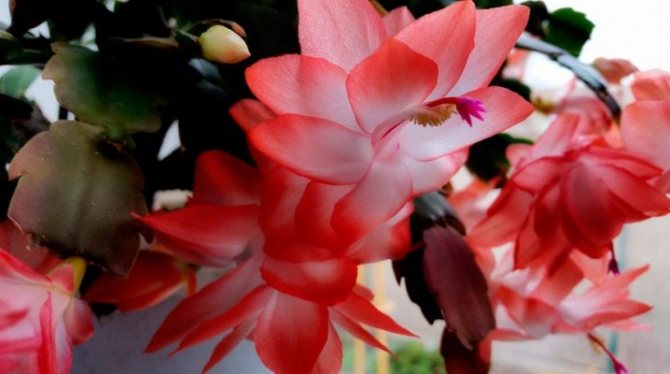

Most indoor plants please their owners with beautiful, bright and fragrant flowers in the spring and summer, when their colors merge with the greenery of nature. During the winter frost, most plants slow down their growth and go into a state of dormancy. One of the most popular domestic flowers, the Decembrist, will be able to surprise with abundant flowering before the New Year holidays. Florists recommend that you definitely purchase this plant, carefully study its features and care rules, then not only a Christmas tree will be a New Year's decoration, but also a luxurious flower.

